
Deutsch-Chinesische Enzyklopädie, 德汉百科
 Palestine
Palestine


伊斯兰教是与佛教和基督教并列的世界三大宗教。公元七世纪初诞生于阿拉伯半岛。它是由伊斯兰教的先知穆罕默德所创,目前世界上有10亿多信徒,他们大多分布在阿拉伯国家,以及中非、北非、中亚、西亚、东南亚和印度、巴基斯坦、中国;有些国家还以伊斯兰教为国教。
伊斯兰教诞生于阿拉伯半岛的社会大变动时期。四方割据,战乱频繁。内忧外患,危机重重。在宗教信仰上,原始宗教盛行,人们崇拜自然物体,并且各个部落 都有自己的神,同时,犹太教和基督教也开始向半岛传播,但它们的学说并不适合这种形势。因此实现半岛的和平统一和社会安宁是阿拉伯社会的出路。这时候先知 穆罕默德出现了,他以"安拉是唯一的真神"为口号,提出禁止高利贷,"施舍济贫""和平安宁"等主张,反映了当时社会的要求。伊斯兰教就是在这样一个转折 的时刻诞生的。
(Quelle:http://cn.netor.com/know/islam/islan1.htm)
伊斯兰教(阿拉伯语:الإسلام, al-’islām;发音:[ʔislæːm] ![]() 聆听[注 1])又称回教、清真教、回回教、天方教、大食法、大食教度,伊斯兰教是以《古兰经》和圣训为教导的一神教宗教,也是世界三大宗教之一。《古兰经》被伊斯兰信徒(穆斯林)视为造物主安拉命天使给其使者逐字逐句的启示,而圣训为造物主最后的先知穆罕默德的言行录(由同伴们转述收集)。伊斯兰这一名称来自《古兰经》,源自闪语字根S-L-M,意为“顺从(造物主)”;实际上穆斯林(伊斯兰教徒)的名字也来自这个字根,意为“顺从者”、“实现和平者”。
聆听[注 1])又称回教、清真教、回回教、天方教、大食法、大食教度,伊斯兰教是以《古兰经》和圣训为教导的一神教宗教,也是世界三大宗教之一。《古兰经》被伊斯兰信徒(穆斯林)视为造物主安拉命天使给其使者逐字逐句的启示,而圣训为造物主最后的先知穆罕默德的言行录(由同伴们转述收集)。伊斯兰这一名称来自《古兰经》,源自闪语字根S-L-M,意为“顺从(造物主)”;实际上穆斯林(伊斯兰教徒)的名字也来自这个字根,意为“顺从者”、“实现和平者”。
信仰独一且无与伦比的安拉,并认为人生的唯一目的是崇拜或顺从安拉;伊斯兰教认为安拉在人类历史长河派遣了众多先知给全人类,历代各个民族都有先知,包括易卜拉欣(亚伯拉罕)、穆萨(摩西)、尔撒(耶稣)等,先知穆罕默德是最后一位,古兰经载有他所得的讯息。伊斯兰教的基本功修包括五功,是为“念、礼、斋、课、朝”,五功是穆斯林需要奉行的五个义务[1]。伊斯兰教还拥有自己的一套宗教法律,该法律实际触及生活及社会的每一个层面,由饮食、金融到战事以及福利等各方面。
在先知穆罕默德逝世后,伊斯兰帝国持续扩张,占据着大片的地区,促使哈里发国的诞生,传教活动亦刺激更多人改信伊斯兰教[2]。早期哈里发的宗教政策、穆斯林的经济及商贸开拓及后来奥斯曼帝国的扩张都使伊斯兰教从麦加向大西洋及太平洋的方向扩散,形成穆斯林世界。
多数的穆斯林属于逊尼派(素尼派)(75%-90%)及什叶派(10%-20%)两大派别[参 1][参 2][3],另外两派中均有人同时信仰伊斯兰神秘主义[4]。伊斯兰教是中东、中亚、东南亚主要部分及非洲的大部分的主流宗教。在法国、德国、中国西北部、俄罗斯西南部及加勒比地区都可找到庞大的穆斯林社群。穆斯林最多的国家是印度尼西亚,这里居住着全球穆斯林总数的15%[5]。南亚、中东及撒哈拉以南非洲的穆斯林分别占全球总数的25%、20%及15%[参 2]。皈依伊斯兰教的穆斯林几乎可在世界的每个角落都可找到。截至2010年,全球约有16亿穆斯林,占23.4%人口[参 3]。在信徒人数上,伊斯兰教是世界第二大宗教,被认为是世上增长得最快的宗教[6][参 4]。
Der Islam ist eine monotheistische Religion, die im frühen 7. Jahrhundert n. Chr. in Arabien durch Mohammed gestiftet wurde. Mit über 1,8 Milliarden[1] Mitgliedern ist der Islam nach dem Christentum (ca. 2,2 Milliarden Mitglieder)[2] heute die Weltreligion mit der zweitgrößten Mitgliederzahl.
Der Islam wird allgemein auch als abrahamitische,[3] als prophetische[4] Offenbarungsreligion[5] und als Buch- oder Schriftreligion[6] bezeichnet.
Das arabische Wort Islām (islām / إسلام) ist ein Verbalsubstantiv zu dem arabischen Verb aslama („sich ergeben, sich hingeben“). Es bedeutet wörtlich das „Sich-Ergeben“ (in den Willen Gottes), „Sich-Unterwerfen“ (unter Gott), „Sich-Hingeben“ (an Gott), oft einfach mit Ergebung, Hingabe und Unterwerfung wiedergegeben.[7]
Die Bezeichnung für denjenigen, der dem Islam angehört, ist Muslim. Die Pluralform im Deutschen ist Moslems oder Muslime, Muslimas oder Musliminnen.
Die zehn Länder mit dem größten Anteil an der muslimischen Weltbevölkerung sind Indonesien (12,9 %), Pakistan (11,1 %), Indien (10,3 %), Bangladesch (9,3 %), Ägypten und Nigeria (jeweils 5 %), Iran und Türkei (jeweils 4,7 %) sowie Algerien (2,2 %) und Marokko (ca. 2 %). In ihnen zusammengenommen leben mehr als zwei Drittel aller Muslime.[8] Die wichtigste überstaatliche islamische Organisation ist die Organisation für Islamische Zusammenarbeit (OIC) mit Sitz in Dschidda. Ihr gehören 56 Staaten an, in denen der Islam Staatsreligion, Religion der Bevölkerungsmehrheit oder Religion einer großen Minderheit ist. Teilweise muslimisch geprägte europäische Länder sind Albanien, Bosnien und Herzegowina, Kosovo, Nordmazedonien und die (geographisch nur teilweise in Europa liegende) Türkei. Viele weitere Länder haben muslimische Minderheiten.
Die wichtigste textliche Grundlage des Islams ist der Koran (arabisch القرآن al-qurʾān ‚Lesung, Rezitation, Vortrag‘), der als die dem Propheten Mohammed offenbarte Rede Gottes gilt.
Die zweite Grundlage bilden die Hadithe (arabisch حديث, DMG ḥadīṯ ‚Erzählung, Bericht, Mitteilung, Überlieferung‘) zur Sunna Mohammeds (Sunna, arabisch سنة ‚Brauch, gewohnte Handlungsweise, überlieferte Norm‘), der als der „Gesandte Gottes“ (Rasūl, arabisch رسول ‚Gesandter, Sendbote, Apostel‘‘) Vorbildcharakter für alle Muslime hat.
Die sich aus diesen Texten ergebenden Normen werden in ihrer Gesamtheit als Scharia bezeichnet (شريعة / šarīʿa im Sinne von „Weg zur Tränke, Weg zur Wasserquelle, deutlicher, gebahnter Weg“; auch: „religiöses Gesetz“, „Ritus“).
イスラム教(イスラムきょう、イスラーム教、イスラーム、和名・漢字圏名: 回教)は、唯一絶対の神(アラビア語でアッラー)を信仰し、神が最後の預言者を通じて人々に下した(啓示した)とされるクルアーンの教えを信じ、従う一神教である。
ユダヤ教やキリスト教の影響を受けた唯一神教で、偶像崇拝[注釈 1]を徹底的に排除し、神への奉仕を重んじ、信徒同士の相互扶助関係や一体感を重んじる点に大きな特色があるとされる。アッラーを崇拝するが、アッラーとは、もともとアラビアの多神教の神々の中の一人であった[1]が、ムハンマドがメッカを占領すると、他の多神教の神々の像は全て破壊され、そして作ることや描くことも禁止され、その神だけを崇拝するようになった。
日本語における「イスラーム」(isurāmu) はアラビア語のإسلام (islām) の長母音に即した形でカタカナに音写した語である。この語は、「自身の重要な所有物を他者の手に引き渡す」という意味を持つaslama(アスラマ)という動詞の名詞形であり、神への絶対服従を表す。ムハンマド以前のジャーヒリーヤ時代には宗教的な意味合いのない人と人との取引関係を示す言葉として用いられていた。ムハンマドはこのイスラームという語を、唯一神であるアッラーフに対して己の全てを引き渡して絶対的に帰依し服従するという姿勢に当てはめて用い、そのように己の全てを神に委ねた状態にある人をムスリムと呼んだ。このような神とムスリムとの関係はしばしば主人と奴隷の関係として表現される[2]。
イスラームの啓典であるクルアーンの中の法制的部分やムスリム(イスラム教徒)の従うべき規範を定めたシャリーア(イスラム法)を重視する論者は、『イスラームはその定めにのっとって行うべき行為として単に宗教上の信仰生活のみを要求しているのではなく、イスラム国家の政治のあり方、ムスリム間やムスリムと異教徒の間の社会関係にわたるすべてを定めている。』と主張している。このことから、『イスラームとは、単なる宗教の枠組みに留まらない、ムスリムの信仰と社会生活のすべての側面を規程する文明の体系である』という理解の仕方がある。
この理解に基づいて、近年はイスラーム研究者の間で「イスラム教」あるいは「イスラーム教」という「宗教」の側面のみを意味する「教 (-ism)」の字を取り去って単に「イスラーム」と表記すべきであるという主張が行われ、ある程度の市民権を得つつある。この主張に従えば、イスラームの規程する諸側面すべてをイスラームと呼び、宗教としての側面をイスラム教、イスラーム教と呼んで区別できる可能性もある。
しかし一方で、このようなイスラーム理解はイスラームの律法的側面を過度に強調しており、スーフィズムにみられる精神主義などの多様なイスラームの形態を反映していない、という批判も強い。
Islam (/ˈɪslɑːm/)[note 1] is an Abrahamic monotheistic religion teaching that there is only one God (Allah),[1] and that Muhammad is the messenger of God.[2][3] It is the world's second-largest religion[4] with over 1.8 billion followers or 24% of the world's population,[5] most commonly known as Muslims.[6] Muslims make up a majority of the population in 50 countries.[4] Islam teaches that God is merciful, all-powerful, unique[7] and has guided humankind through prophets, revealed scriptures and natural signs.[3][8] The primary scriptures of Islam are the Quran (revealed in Classical Arabic), viewed by Muslims as the verbatim word of God, and the teachings and normative example (called the sunnah, composed of accounts called hadith) of Muhammad (c. 570 – 8 June 632 CE).
Muslims believe that Islam is the complete and universal version of a primordial faith that was revealed many times before through prophets including Adam, Abraham, Moses and Jesus.[9][10][11] Muslims consider the Quran to be the unaltered and final revelation of God.[12] Like other Abrahamic religions, Islam also teaches a final judgment with the righteous rewarded paradise and unrighteous punished in hell.[13][14] Religious concepts and practices include the Five Pillars of Islam, which are obligatory acts of worship, and following Islamic law (sharia),[verification needed] which touches on virtually every aspect of life and society, from banking and welfare to women and the environment.[15][16] The cities of Mecca, Medina and Jerusalem are home to the three holiest sites in Islam.[17]
Aside from the theological narrative,[18][19][20] Islam is historically believed to have originated in the early 7th century CE in Mecca,[21] and by the 8th century the Umayyad Islamic caliphate extended from Iberia in the west to the Indus River in the east. The Islamic Golden Age refers to the period traditionally dated from the 8th century to the 13th century, during the Abbasid Caliphate, when much of the historically Muslim world was experiencing a scientific, economic and cultural flourishing.[22][23][24] The expansion of the Muslim world involved various caliphates such as the Ottoman Empire, traders and conversion to Islam by missionary activities (dawah).[25]
Most Muslims are of one of two denominations; Sunni (85–90%)[26] or Shia (10–15%).[27] About 13% of Muslims live in Indonesia, the largest Muslim-majority country,[28] 31% of Muslims live in South Asia,[29] the largest population of Muslims in the world,[30] 20% in the Middle East–North Africa,[31] where it is the dominant religion,[32] and 15% in Sub-Saharan Africa.[33] Sizeable Muslim communities are also found in the Americas, the Caucasus, Central Asia, China, Europe, Mainland Southeast Asia, the Philippines, and Russia.[34][35] Islam is the fastest-growing major religion in the world.[36][37][38]
L'islam (arabe : الإسلام ; Alʾislām, la soumission et la sujétion aux ordres de Dieu1) est une religion abrahamique s'appuyant sur le dogme du monothéisme absolu (تَوْحيد, tawhid) et prenant sa source dans le Coran, considéré comme le réceptacle de la parole de Dieu (الله, Allah) révélée à Mahomet (محمّد, Muḥammad), proclamé par les adhérents de l'islam comme étant le dernier prophète de Dieu2, au VIIe siècle en Arabie au sud-ouest de l'Asie3. Un adepte de l'islam est appelé un musulman ; il a des devoirs cultuels, souvent appelés les « piliers de l'islam ».
En 2015, le nombre de musulmans dans le monde est estimé à 1,8 milliard, soit 24 % de la population mondiale4, ce qui fait de l'islam la deuxième religion du monde après le christianisme et devant l'hindouisme. C’est, chronologiquement parlant, le troisième grand courant monothéiste de la famille des religions abrahamiques, après le judaïsme et le christianisme, avec lesquels il possède des éléments communs.
L’islam se répartit en différents courants, dont les principaux sont le sunnisme, qui représente 90 % des musulmans5, le chiisme et le kharidjisme.
Les musulmans croient que Dieu est indivisible (sans fils)6 et inimaginable (sans image)7 et que l'islam est la religion naturelle au sens où elle n'a pas besoin de la foi en l'unicité divine pour constater l'existence de Dieu, cette vérité étant donnée tout entière dès le premier jour et dès le premier Homme (soit Adam)8. Ainsi, elle se présente comme un retour sur les pas d'Abraham (appelé, en arabe, Ibrahim par les musulmans) du point de vue de la croyance, le Coran le définissant comme étant l'étalon-pied, la lieue de la Kaaba, le mille d'Abraham (milla ta Ibrahim)9,10,11, c'est-à-dire une soumission exclusive à la volonté d'Allahnote 1,note 2,note 3.
Le Coran reconnaît l'origine divine de l'ensemble des livres sacrés du judaïsme et du christianismenote 4, tout en estimant qu'ils seraient, dans leurs interprétations actuelles, le résultat d'une falsification partielle12 : le Suhuf-i-Ibrahim (les Feuillets d'Abraham), la Tawrat (le Livre de Moïse13 identifié à la Torah), le Zabur de David et Salomon (identifié au Livre des Psaumes) et l'Injil (l'Évangile de Jésus14).
Le Coran établit l'importance de la Sunna de Mahomet qui est connue par des transmissions de ses paroles, faits et gestes, approbations (y compris silencieuses)15,note 5, récits appelés hadîths, auxquels se réfèrent la majorité des musulmans pour l'établissement de règles juridiques (fiqh) permettant la compréhension et l'accomplissement des adorations du musulman au quotidien. Les différentes branches de l'islam ne s'accordent pas sur les compilations de hadiths à retenir comme authentiques. Le Coran et les hadiths dits « recevables » sont deux des quatre sources de la loi islamique, la charia, les deux autres étant le consensus (ijma’) et l'analogie (qiyas). Il établit également le devoir d'aimer la famille de Mahomet (ahl al-bayt).
L'islam (pronunciato in italiano AFI: /iˈzlam/ (tradizionale) o /ˈizlam/ (comune)[1][2]; in arabo: إسلام, Islām [ʔɪˈslæːm][3]) è una religione monoteista manifestatasi per la prima volta nella penisola araba, nella cittadina higiazena della Mecca, nel VII secolo dell'era cristiana ad opera di Maometto (in arabo محمد, Muḥammad), considerato dai musulmani l'ultimo profeta portatore di legge (Khātam al-Nabiyyīn), inviato da Dio (in arabo الله, Allāh) al mondo per ribadire definitivamente la Rivelazione, annunciata per la prima volta ad Adamo (آدم, Ādam), il primo uomo e il primo profeta.
Con circa 1,8 miliardi di fedeli, ossia il 23% della popolazione mondiale,[4][5] l'islam è la seconda religione del mondo per consistenza numerica e vanta un tasso di crescita particolarmente significativo.[6][7][8] Il 13% dei musulmani vive in Indonesia, che è anche il paese musulmano più popolato, il 25% nell'Asia meridionale, il 20% in Vicino Oriente, Maghreb e Medio Oriente e il 15% nell'Africa subsahariana.[9] Minoranze considerevoli si trovano anche in Europa, Cina, Russia e America.
Il simbolo della mezzaluna islamica è stato introdotto dagli ottomani con la presa di Costantinopoli nel 1453.
El islam23 (en árabe: الإسلام, ![]() al-Islām (?·i)) es una religión monoteísta abrahámica cuyo dogma se basa en el Corán, el cual establece como premisa fundamental para sus creyentes que «No hay más Dios que Alá4 y que Mahoma es el último mensajero de Alá».5 La palabra árabe Allah, hispanizada como Alá, significa Dios y su etimología es la misma de la palabra semítica El, con la que se nombra a Dios en la Biblia. Los eruditos islámicos definen al islam como: «La sumisión a Dios el Altísimo a través del monoteísmo, la obediencia y el abandono de la idolatría».6 Los seguidores del islam se denominan musulmanes (del árabe muslim مسلم, 'que se somete'). Creen que Mahoma es el último de los profetas enviados por Dios y sello de la Profecía.7 El libro sagrado del islam es el Corán,8 que según los musulmanes fue dictado por Alá a Mahoma a través de Yibril (el arcángel Gabriel).
al-Islām (?·i)) es una religión monoteísta abrahámica cuyo dogma se basa en el Corán, el cual establece como premisa fundamental para sus creyentes que «No hay más Dios que Alá4 y que Mahoma es el último mensajero de Alá».5 La palabra árabe Allah, hispanizada como Alá, significa Dios y su etimología es la misma de la palabra semítica El, con la que se nombra a Dios en la Biblia. Los eruditos islámicos definen al islam como: «La sumisión a Dios el Altísimo a través del monoteísmo, la obediencia y el abandono de la idolatría».6 Los seguidores del islam se denominan musulmanes (del árabe muslim مسلم, 'que se somete'). Creen que Mahoma es el último de los profetas enviados por Dios y sello de la Profecía.7 El libro sagrado del islam es el Corán,8 que según los musulmanes fue dictado por Alá a Mahoma a través de Yibril (el arcángel Gabriel).
Se aceptan como profetas principalmente (pero no limitándose) a Adán, Noé, Abraham, Moisés, Salomón y Jesús (llamado Isa). Además del Corán, los musulmanes de tradición sunita siguen así mismo los hadices y la sunna del profeta Mahoma, que conforman el Registro histórico de las acciones y las enseñanzas del Profeta. Se aceptan también como libros sagrados la Torá (el Pentateuco de los cristianos), los Libros de Salomón y los Evangelios (el Nuevo Testamento).
El islam es una religión abrahámica monoteísta que adora exclusivamente a Alá sin copartícipes. Es la segunda religión más grande del mundo, tras el cristianismo y la que tiene mayor crecimiento en términos de seguidores, quienes se estima alcanzan a 1.8 miles de millones o el 24.1% de la población, quienes se conoce como musulmanes. Los musulmanes son la mayoría de la población en 50 países.
El islam se inició con la predicación de Mahoma en el año 622 en La Meca (en la actual Arabia Saudita). Bajo el liderazgo de Mahoma y sus sucesores, el islam se extendió rápidamente. Existe discrepancia entre los musulmanes y no musulmanes de si se extendió por imposición religiosa o militar, o por conversión de los pueblos al islam.
Исла́м (араб. الإسلام — «покорность»[1], «предание себя [Единому] Богу»[1]) — самая молодая[2] и вторая по численности приверженцев, после христианства, мировая монотеистическая авраамическая религия[1]. Число приверженцев — более 1,8 млрд человек, проживающих в более чем 125 странах мира[3]. В 28 странах ислам является государственной или официальной религией. Большинство мусульман (85-90 %) составляют сунниты, остальные — шииты, ибадиты[1]. Проповедник ислама — пророк Мухаммед (571—632)[1]. Священная книга — Коран[1]. Второй важнейший источник исламского вероучения и права — Сунна, представляющая совокупность преданий (хадис) об изречениях и деяниях пророка Мухаммеда[1]. Язык богослужения — арабский[1]. Приверженцев ислама называют мусульманами.
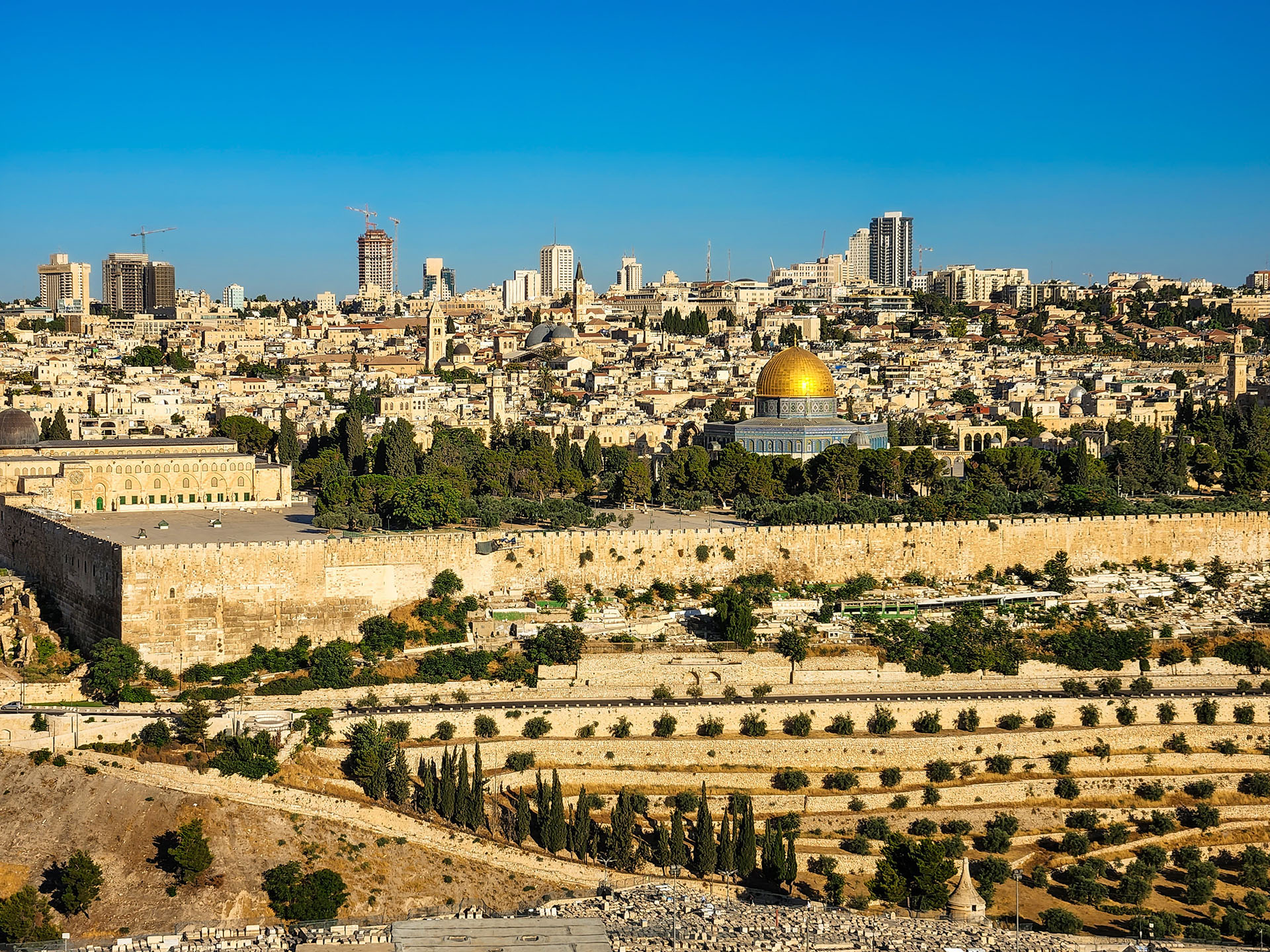

耶路撒冷市 (Jerusalem) 位于巴勒斯坦中部犹地亚山的四座山丘上,是一座举世闻名的历史古城,距今已有5000多年的历史。四周群山环抱,面积158平方公里,由东部旧城和西部新城组成。海拔835米,63.4万(2000年),是以色列最大城市。
耶路撒冷旧城是一座宗教圣城,是犹太教、伊斯兰教和基督教世界三大宗教发源地,三教都把耶路撒冷视为自己的圣地。宗教和传统、历史和神学以及神圣的处所和祈祷的房屋,使耶路撒冷成为备受犹太教徒、基督教徒和穆斯林崇敬的神圣城市。 耶路撒冷所在地最早叫“耶布斯”,这是因为很早以前阿拉伯迦南人的一个名叫“耶布斯”的部落从阿拉伯半岛迁徙到这里定居下来,修建村庄,构筑城堡,并以部 落的名字命名此地。后来,迦南人又在这里修建城市,并定名为“尤罗萨利姆”。大约在公元前一千年左右,犹太王国创始人大卫征服了这个地方,将它作为犹太王 国的都城,继续沿用“尤罗萨利姆”的名称,为使它希伯莱化,称为“尤罗萨拉姆”。 中文以此译为“耶路撒冷”,意为“和平之城”。阿拉伯人称该城为“古德斯”,即“圣城”。 (Quelle: www.mjjq.com/)
耶路撒冷(希伯来语: יְרוּשָׁלַיִם,拉丁化:Yerushaláyim;阿拉伯语:
יְרוּשָׁלַיִם,拉丁化:Yerushaláyim;阿拉伯语: القُدس,拉丁化:al-Quds,汉译:古都斯或古德斯,意为“神圣的”;唐朝时期的景教徒曾根据叙利亚语“Ūrišlem”译作乌梨师敛[2][3])为以色列和巴勒斯坦境内的一座城市,位于地中海和死海之间,是古代巴勒斯坦中部的全球宗教重镇,也是完整保留人类信仰文明演进史的一个历史城市。耶路撒冷同时是犹太教、基督教和伊斯兰教三大亚伯拉罕宗教(或称“三大天启宗教”)的圣地。自公元前10世纪,所罗门王建成第一圣殿起,耶路撒冷一直是犹太教信仰的中心和最神圣的城市[4],昔日圣殿的遗迹西墙,仍是犹太教最神圣的所在。基督徒也相当重视耶路撒冷,因为根据《圣经》记载,耶稣在这里受难、埋葬、复活、升天。伊斯兰教亦将耶路撒冷列为麦加、麦地那之后的第三圣地,以纪念穆罕默德的夜行登霄[5],并在圣殿山上建造2座清真寺——阿克萨清真寺和圆顶清真寺来纪念这一事件。
القُدس,拉丁化:al-Quds,汉译:古都斯或古德斯,意为“神圣的”;唐朝时期的景教徒曾根据叙利亚语“Ūrišlem”译作乌梨师敛[2][3])为以色列和巴勒斯坦境内的一座城市,位于地中海和死海之间,是古代巴勒斯坦中部的全球宗教重镇,也是完整保留人类信仰文明演进史的一个历史城市。耶路撒冷同时是犹太教、基督教和伊斯兰教三大亚伯拉罕宗教(或称“三大天启宗教”)的圣地。自公元前10世纪,所罗门王建成第一圣殿起,耶路撒冷一直是犹太教信仰的中心和最神圣的城市[4],昔日圣殿的遗迹西墙,仍是犹太教最神圣的所在。基督徒也相当重视耶路撒冷,因为根据《圣经》记载,耶稣在这里受难、埋葬、复活、升天。伊斯兰教亦将耶路撒冷列为麦加、麦地那之后的第三圣地,以纪念穆罕默德的夜行登霄[5],并在圣殿山上建造2座清真寺——阿克萨清真寺和圆顶清真寺来纪念这一事件。
自1967年第三次中东战争之后,以色列控制了全部的耶路撒冷地区,包括西耶路撒冷和东耶路撒冷,以及老城区。以色列和巴勒斯坦都声称耶路撒冷是他们的首都,因为以色列坚称这里是他们主要的政府机构,而巴勒斯坦则称预见这座城市是他们的政权所在地。不过,这两个声称在国际社会上都没有得到广泛的承认,认为该市的最终地位尚未确定,有待以色列和巴勒斯坦双方谈判决定。多数国家都将大使馆设在特拉维夫[6][7]。今天耶路撒冷仍然是以巴冲突的中心。以色列现行政区划上设耶路撒冷区,面积652平方公里,只有一个分区,即耶路撒冷分区。
2006年,耶路撒冷市区面积为126平方公里,人口约724,000人,这两项指标均居以色列和巴勒斯坦各城市之首[8][9][10]。
今天的耶路撒冷,是一个对比强烈的城市,不同文化、不同宗教、不同民族、社会不同阶层,同处一城;城市的东西两部分截然不同,发展水平悬殊。老城雅法门以西的西耶路撒冷(1967年以前属于以色列的市区)是现代以色列的核心地带(如果再继续向西数十公里,就是以特拉维夫为中心的“古什·但”区域),而老城及其东、北、南三面的东耶路撒冷(1967年后以色列占领的争议区域)则以巴勒斯坦人为主。最特别的地方是面积只有1平方公里,被一圈城墙所围绕的耶路撒冷老城[11],其中又分为4个宗教与种族聚居区:犹太区、基督徒区、亚美尼亚区和穆斯林区。耶路撒冷最重要的也引起重大争议的宗教圣地,均位于此处:犹太教的西墙和圣殿山、穆斯林的圆顶清真寺和阿克萨清真寺,以及基督徒的圣墓教堂和苦路。
Jerusalem (hebräisch  ירושלים?/i, Jeruschalajim [jeʁuʃa'lajim]; arabisch القدس al-Quds ‚die Heilige‘; altgriechisch Ἱεροσόλυμα Hierosólyma [n. pl.], oder Ἰερουσαλήμ Ierousalḗm [f., indecl.]; lateinisch Hierosolyma [n. pl. oder f. sg.], Hierosolymae [f. pl.], Hierusalem oder Jerusalem [n., indecl.]) ist eine Stadt in den judäischen Bergen zwischen Mittelmeer und Totem Meer mit rund 882.000 Einwohnern.
ירושלים?/i, Jeruschalajim [jeʁuʃa'lajim]; arabisch القدس al-Quds ‚die Heilige‘; altgriechisch Ἱεροσόλυμα Hierosólyma [n. pl.], oder Ἰερουσαλήμ Ierousalḗm [f., indecl.]; lateinisch Hierosolyma [n. pl. oder f. sg.], Hierosolymae [f. pl.], Hierusalem oder Jerusalem [n., indecl.]) ist eine Stadt in den judäischen Bergen zwischen Mittelmeer und Totem Meer mit rund 882.000 Einwohnern.
In Jerusalem begegnen sich viele Kulturen der Antike und Moderne. Die Altstadt ist in das muslimische, jüdische, christliche und armenische Viertel gegliedert und von einer Mauer umgeben.
Der politische Status der Stadt ist international umstritten und Teil des Nahostkonflikts. Jerusalem wurde von Israel, das das gesamte Stadtgebiet kontrolliert, als seine Hauptstadt deklariert. Der Staat Palästina beansprucht Ost-Jerusalem als seine Hauptstadt. In Jerusalem befinden sich der Sitz des Staatspräsidenten, die Knesset und das Oberste Gericht als Teil des politischen Systems Israels, die 1918 gegründete Hebräische Universität sowie die Holocaustgedenkstätte Yad Vashem und der Israel National Cemetery. Ostjerusalem, das bedeutende religiöse Stätten des Judentums, Christentums und des Islam beherbergt, wird von gemäßigteren Palästinenser-Organisationen jedoch als Hauptstadt eines zukünftigen palästinensischen Staates beansprucht, während radikalere Palästinenser-Organisationen die gesamte Stadt als Hauptstadt fordern.
エルサレムまたはイェルサレムは、イスラエルおよびパレスチナ自治区にある都市。
イスラエルはエルサレムが自国の「首都」であると宣言しているものの、国際連合など国際社会はこれを認めておらず[1][2]、イスラエルの首都はテルアビブであるとみなし[1][2]ている。したがって、イスラエルと国交を持つ諸国も、大使館や領事館はエルサレムでなくテルアビブに置いてきた。ただし、2017年になってアメリカ合衆国のドナルド・トランプ大統領はエルサレムをイスラエルの首都であると明言[1][2]。2018年5月、アメリカ大使館をテルアビブからエルサレムに移転させた[3]。
Jerusalem (/dʒəˈruːsələm/; Hebrew: יְרוּשָׁלַיִם  Yerushaláyim; Arabic: القُدس
Yerushaláyim; Arabic: القُدس  al-Quds)[note 2] is a city in the Middle East, located on a plateau in the Judaean Mountains between the Mediterranean and the Dead Sea. It is one of the oldest cities in the world, and is considered holy to the three major Abrahamic religions—Judaism, Christianity, and Islam. Both Israel and the Palestinian Authority claim Jerusalem as their capital, as Israel maintains its primary governmental institutions there and the State of Palestine ultimately foresees it as its seat of power; however, neither claim is widely recognized internationally.[note 3][8]
al-Quds)[note 2] is a city in the Middle East, located on a plateau in the Judaean Mountains between the Mediterranean and the Dead Sea. It is one of the oldest cities in the world, and is considered holy to the three major Abrahamic religions—Judaism, Christianity, and Islam. Both Israel and the Palestinian Authority claim Jerusalem as their capital, as Israel maintains its primary governmental institutions there and the State of Palestine ultimately foresees it as its seat of power; however, neither claim is widely recognized internationally.[note 3][8]
During its long history, Jerusalem has been destroyed at least twice, besieged 23 times, attacked 52 times, and captured and recaptured 44 times.[9] The part of Jerusalem called the City of David was settled in the 4th millennium BCE.[10] Jerusalem was named as "Urusalim" on ancient Egyptian tablets, probably meaning "City of Shalem" after a Canaanite deity, during the Canaanite period (14th century BCE). During the Israelite period, significant construction activity in Jerusalem began in the 9th century BCE (Iron Age II), and in the 8th century the city developed into the religious and administrative center of the Kingdom of Judah.[11] In 1538, the city walls were rebuilt for a last time around Jerusalem under Suleiman the Magnificent. Today those walls define the Old City, which has been traditionally divided into four quarters—known since the early 19th century as the Armenian, Christian, Jewish, and Muslim Quarters.[12] The Old City became a World Heritage Site in 1981, and is on the List of World Heritage in Danger.[13] Since 1860 Jerusalem has grown far beyond the Old City's boundaries. In 2015, Jerusalem had a population of some 850,000 residents, comprising approximately 200,000 secular Jewish Israelis, 350,000 Haredi Jews and 300,000 Palestinians.[14][note 4] In 2011, the population numbered 801,000, of which Jews comprised 497,000 (62%), Muslims 281,000 (35%), Christians 14,000 (around 2%) and 9,000 (1%) were not classified by religion.[16]
According to the Bible, King David conquered the city from the Jebusites and established it as the capital of the united kingdom of Israel, and his son, King Solomon, commissioned the building of the First Temple.[note 5] These foundational events, straddling the dawn of the 1st millennium BCE, assumed central symbolic importance for the Jewish people.[18][19] The sobriquet of holy city (עיר הקודש, transliterated ‘ir haqodesh) was probably attached to Jerusalem in post-exilic times.[20][21][22] The holiness of Jerusalem in Christianity, conserved in the Septuagint[23] which Christians adopted as their own authority,[24] was reinforced by the New Testament account of Jesus's crucifixion there. In Sunni Islam, Jerusalem is the third-holiest city, after Mecca and Medina.[25][26] In Islamic tradition, in 610 CE it became the first qibla, the focal point for Muslim prayer (salat),[27] and Muhammad made his Night Journey there ten years later, ascending to heaven where he speaks to God, according to the Quran.[28][29] As a result, despite having an area of only 0.9 square kilometres (0.35 sq mi),[30] the Old City is home to many sites of seminal religious importance, among them the Temple Mount with its Western Wall, Dome of the Rock and al-Aqsa Mosque, and the Church of the Holy Sepulchre. Outside the Old City stands the Garden Tomb.
Today, the status of Jerusalem remains one of the core issues in the Israeli–Palestinian conflict. During the 1948 Arab–Israeli War, West Jerusalem was among the areas captured and later annexed by Israel while East Jerusalem, including the Old City, was captured and later annexed by Jordan. Israel captured East Jerusalem from Jordan during the 1967 Six-Day War and subsequently annexed it into Jerusalem, together with additional surrounding territory.[note 6] One of Israel's Basic Laws, the 1980 Jerusalem Law, refers to Jerusalem as the country's undivided capital. All branches of the Israeli government are located in Jerusalem, including the Knesset (Israel's parliament), the residences of the Prime Minister (Beit Aghion) and President (Beit HaNassi), and the Supreme Court. While the international community rejected the annexation as illegal and treats East Jerusalem as Palestinian territory occupied by Israel,[34][35][36][37] Israel has a stronger claim to sovereignty over West Jerusalem.[38][39]
Jérusalem /ʒe.ʁy.za.lɛm/ (ou Salem, également nommée Hiérosolyme ou Solyme en ancien français ; יְרוּשָׁלַיִם Yerushaláyim en hébreu [dénomination israélienne officielle] ; arabe : القدس al Quds ou اورشليم Ûrshalîm [dénomination israélienne officielle en arabe]) est une ville du Proche-Orient que les Israéliens ont érigée en capitale, que les Palestiniens souhaiteraient comme capitale et qui tient une place centrale dans les religions juive, chrétienne et musulmane.
La ville s’étend sur 126 km2 pour une population de 901 300 habitants en 20171. La ville, chef-lieu du district de Jérusalem, est cosmopolite : s'y mêlent de nombreuses religions, peuples, groupes socio-économiques. La partie nommée vieille ville, entourée de remparts, est constituée de deux quartiers à dominante arabe, dits quartier chrétien et quartier musulman, ainsi que d’un quartier à dominante arménienne et d’un quartier à dominante juive.
Gerusalemme (AFI: /ʤeruzaˈlɛmme/[2][3]; in ebraico: יְרוּשָׁלַיִם?, Yerushalayim, Yerushalaim e/o Yerushalaym ascolta[?·info]; in arabo: القُدس, al-Quds, "la (città) santa"[4], sempre in arabo: أُورْشَلِيم, Ūrshalīm, in greco Ιεροσόλυμα, Ierosólyma, in latino Hierosolyma o Ierusalem, per antonomasia è definita "La Città Eterna"[5]), capitale giudaica tra il X e il VI secolo a.C.[6], è la capitale contesa di Israele e città santa nell'Ebraismo, nel Cristianesimo e nell'Islam. Si trova sull'altopiano che separa la costa orientale del Mar Mediterraneo dal Mar Morto, a est di Tel Aviv, a sud di Ramallah, a ovest di Gerico e a nord di Betlemme.
La Città Vecchia e le sue mura, considerate patrimonio dell'umanità dall'UNESCO, racchiudono in meno di un chilometro quadrato molti luoghi di grande significato religioso come il Monte del Tempio, il Muro del pianto, la Basilica del Santo Sepolcro, la Cupola della Roccia e la Moschea al-Aqsa. Nel corso della sua storia Gerusalemme è stata distrutta e ricostruita due volte ed è stata assediata, conquistata e riconquistata in decine di occasioni.
La parte orientale di Gerusalemme è stata occupata[7] dallo Stato di Israele nel 1967, e nel 1980 il parlamento israeliano approvò una legge fondamentale (l'equivalente di un emendamento costituzionale) che proclamava unilateralmente "Gerusalemme, unita e indivisa [...]".[8] Il Consiglio di sicurezza delle Nazioni Unite nella risoluzione 478 ha definito la legge nulla e priva di validità[9], una violazione del diritto internazionale[10] e un serio ostacolo al raggiungimento della pace in Medio Oriente[11][12].
Jerusalén (en hebreo, יְרוּשָׁלַיִם  Yerushaláyim (?·i); en árabe, القـُدْس
Yerushaláyim (?·i); en árabe, القـُدْس  al-Quds (?·i)) es la capital de Israel y su ciudad más grande y poblada, con 865 7004 residentes en un área de 125,1 kilómetros cuadrados.2 Los asentamientos más antiguos en Jerusalén son del V milenio a. C. y es una de las ciudades más antiguas del mundo.5 Jerusalén tiene un profundo significado religioso para el cristianismo, el judaísmo y el islam. Geográficamente, se sitúa en los montes de Judea, entre el mar Mediterráneo y la ribera norte del mar Muerto, y se ha extendido bastante más allá de los límites de la Ciudad Vieja.
al-Quds (?·i)) es la capital de Israel y su ciudad más grande y poblada, con 865 7004 residentes en un área de 125,1 kilómetros cuadrados.2 Los asentamientos más antiguos en Jerusalén son del V milenio a. C. y es una de las ciudades más antiguas del mundo.5 Jerusalén tiene un profundo significado religioso para el cristianismo, el judaísmo y el islam. Geográficamente, se sitúa en los montes de Judea, entre el mar Mediterráneo y la ribera norte del mar Muerto, y se ha extendido bastante más allá de los límites de la Ciudad Vieja.
El estatus de la parte oriental de la ciudad, conquistada en 1967 por Israel, se encuentra disputado, ya que en este sector —referido habitualmente como Jerusalén Este o Jerusalén Oriental, que incluye la Ciudad Vieja— es donde el Estado de Palestina pretende establecer su capital. Israel discute las reclamaciones palestinas y, tras la Guerra de los Seis Días, considera la ciudad como un todo unificado y un mismo municipio, declarándola como su capital "eterna e indivisible" mediante la Ley de Jerusalén en 1980. Esta anexión ha provocado un amplio rechazo en la comunidad internacional, materializado en la resolución 478 del Consejo de Seguridad de la ONU, que la consideró contraria al Derecho Internacional,6 y en señal de protesta por este acto unilateral los Estados miembros de las Naciones Unidas acabaron por trasladar sus embajadas a Tel Aviv, tal como pedía la resolución.
Jerusalén fue habitada por los jebuseos antes de la llegada de las tribus hebreas a Canaán a principios del siglo XIII a. C. Históricamente, y según la tradición, fue la antigua capital del Reino de Israel y del Reino de Judá, y siglos más tarde del reino franco de Jerusalén.7
La Ciudad Vieja de Jerusalén fue declarada Patrimonio de la Humanidad por la Unesco en 1981.
Иерусали́м (ивр. יְרוּשָׁלַיִם Йерушала́(й)им (audio) (инф.), араб. القُدس аль-К̣удс[комм. 1], أورشليم Ӯршалӣм (Ӯрушалӣм)[комм. 2], أورشليم القدس, Ӯршалӣм-аль-К̣удс[комм. 3] (audio) (инф.)) — столица Израиля[3][4][5][6][7], город на Ближнем Востоке. Расположен на плато в Иудейских горах на водоразделе между Средиземным и Мёртвым морями, на высоте 650—840 м над уровнем моря; климат средиземноморский, с жарким, сухим летом и мягкой, влажной зимой. Город является священным для трёх крупнейших авраамических религий — иудаизма, христианства и ислама. Населён представителями множества национальных, этнических и религиозных деноминаций; численность населения Иерусалима (без пригородов) составляет 865 721 жителей.
23 января 1950 года Кнессет (Израильский парламент) провозгласил Иерусалим столицей Государства Израиль[8]; с 1967 года в результате Шестидневной войны Израиль стал контролировать всю территорию города: как Западный Иерусалим, так и Восточный. В 1980 году Кнессет провозгласил Иерусалим единой и неделимой столицей Израиля[3][9]. Израильский суверенитет над восточной частью города[10] и статус всего Иерусалима как столицы Израиля не признаны значительной частью международного сообщества[11][12][13], которое относится к Восточному Иерусалиму как к палестинской территории, оккупированной Израилем[14][15][16][17]. Статус Иерусалима остаётся одной из центральных тем палестино-израильского конфликта.
Иерусалим является одним из древнейших городов мира: первые поселения датируются IV тысячелетием до н. э. В XI веке до н. э. город был занят евреями и провозглашён столицей Израильского царства, а с X века до н. э. — Иудейского. После распада Римской империи Иерусалим отошёл к Византии. С этого момента начинается христианизация города. C захватом в 639 году арабским халифом Умаром ибн Хаттабом город начинает приобретать мусульманский облик. В 1099—1187 и 1229—1244 годах Иерусалим был под властью крестоносцев.
В 1538 году при Сулеймане Великолепном вокруг Иерусалима были построены стены. Сегодня эти стены определяют границы Старого города, который традиционно разделяется на четыре квартала, известные с начала XIX века как Армянский, Христианский, Еврейский и Мусульманский кварталы[18]. В 1981 г. Старый город стал объектом Всемирного наследия, и включён в Список всемирного наследия, находящегося под угрозой[19]. Современный Иерусалим разросся далеко за пределы границ Старого города.
Исторически в основе экономики города лежит его привлекательность для паломников и светских туристов. Однако всё большую роль в экономике Иерусалима играют современные высокотехнологичные предприятия; в 2005 году город признан одним из пяти наиболее динамично развивающихся технологических центров планеты. В Иерусалиме также расположены многие художественные и культурные площадки, в том числе всемирно известный Музей Израиля. Город является государственным телерадиовещательным центром страны. Основанный в 1925 г. Еврейский университет в Иерусалиме входит в первые две сотни учебных заведений мира.
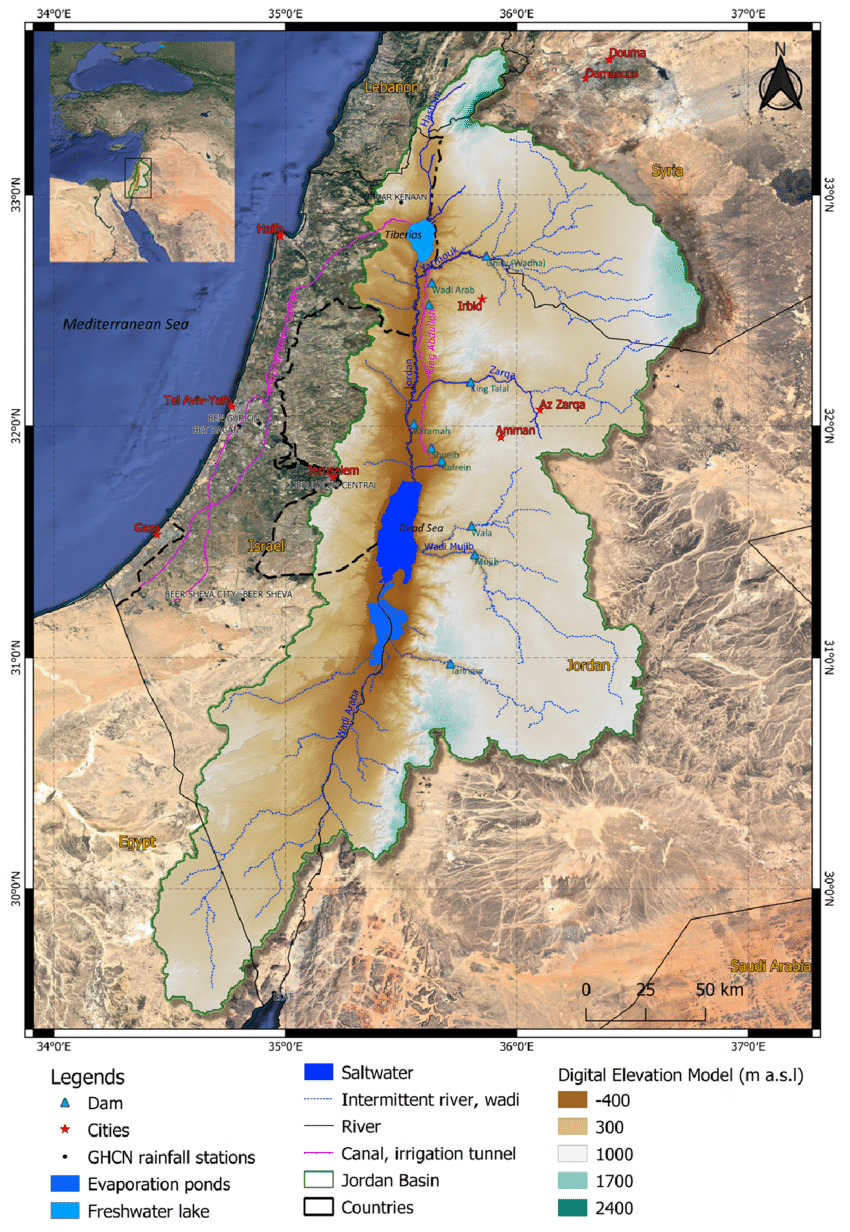
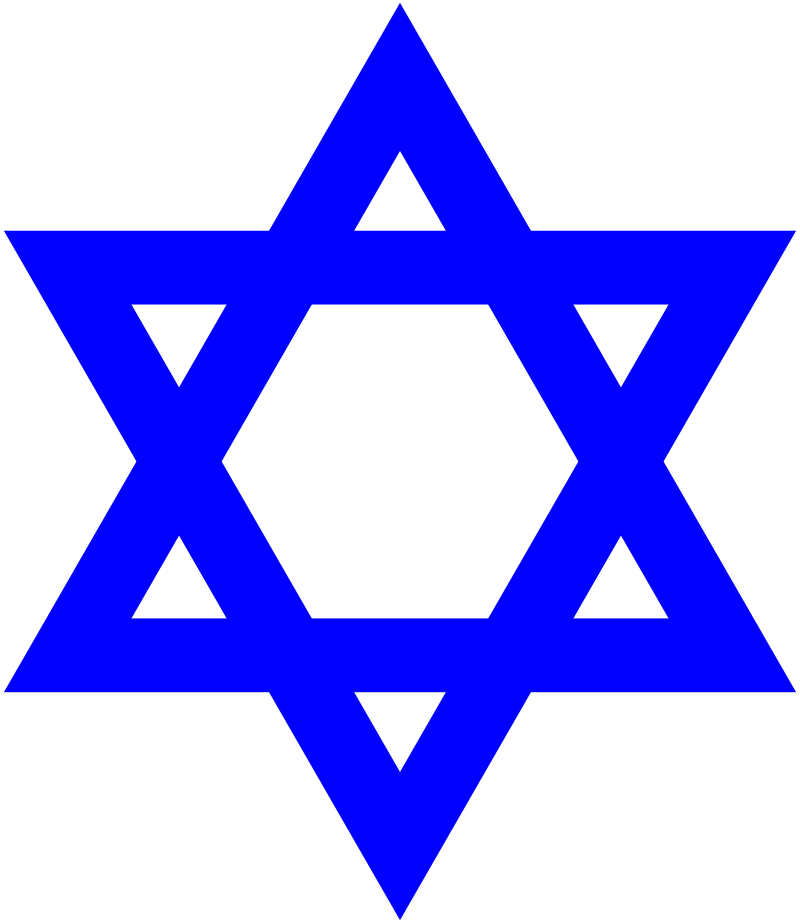
犹太教(希伯来语:יהדות Yahadut),中文曾俗称挑筋教[注 1]或一赐乐业教,是在公元前西亚地区的游牧民族希伯来人中产生的,是犹太人的信仰、价值观和生活方式。犹太教是一神论的宗教,其主要经典是包括妥拉(摩西五经)在内的塔纳赫(即希伯来圣经,基督教称为旧约圣经),以及包括口传律法(密西拿)、口传律法注释(革马拉)以及圣经注释(米德拉什)在内的塔木德,对信奉犹太教的犹太人而言,犹太教是上帝和以色列人立约的关系[1]。
犹太人是一种宗教及种族结合的群体[2],包括生来就是犹太人,或是皈依犹太教的人。在2012年时,犹太人人口估计共1400万,约占世界总人口的0.2%[3]。其中42%住在以色列,其余42%住在美国和加拿大,剩下的大部分住在欧洲,其余的住在南美、亚洲、非洲及澳洲[4]。
犹太教崇拜独一的真神(一神信仰,希伯来语:יהוה),是希伯来人内部的民族宗教。犹太教认为《塔木德》是仅次于《希伯来圣经》的经籍。当亚历山大大帝征服希伯来人的犹太原居地后,希伯来人也易名为犹太人并散落到希腊帝国各处,公元前3世纪,希腊化的埃及托勒密王朝君主托勒密二世,召集70多位懂希腊语的犹太人,集中整理犹太教文献并译成希腊语,即目前基督教使用的希腊语圣经中的旧约全书部分,所谓七十士译本。后来犹太国被罗马帝国彻底摧毁,犹太教位于耶路撒冷的圣殿被拆毁,只留下一段残破的西墙(俗称哭墙),犹太人散落到欧亚各地。
历史上,犹太人在世界各地面对多次毁灭性的灾难和逼害。犹太人由于两千多年一直分散在世界各地,语言、文字已经分化,只是靠着统一的宗教及文化维系其单一的民族性。
基督宗教方面,由于新约圣经记载犹太人逼害基督徒,且杀害耶稣基督,尽管早年的基督徒也是犹太人,只是后来使徒保罗(圣保罗)等把基督教传至罗马帝国,信仰基督教的人远多于犹太人。
天主教会及正教会在逾千年历史一直迫害犹太人,教宗若望·保禄二世在1992年,承认天主教会对抗及歧视犹太人,造成了他们逾承受苦难昀历史。
部分犹太人向往自己民族的辉煌历史。19世纪,犹太复国主义(锡安主义)思潮兴起,各地犹太人以买地,驱赶,掠夺等手段陆续回到巴勒斯坦,建立以色列这个世界上唯一犹太国家。
由于在遵守方式和程度的差异,现今的犹太教主要有三大派系,分别是正统派、保守派及改革派。在三大派系之外,卡拉派也是犹太教的组成部分,可萨人信奉的就是卡拉派,目前卡拉派在以色列约有40000名信徒。
一些宗教学者将犹太教、基督教和伊斯兰教通称为亚伯拉罕诸教,因为三者均奉旧约中的亚伯拉罕为他们的先知。
Unter Judentum (von griechisch ἰουδαϊσμός ioudaismos, hebräisch יהדות Jahadut) versteht man einerseits die Religion, die Traditionen und Lebensweise, die Philosophie und meist auch die Kulturen der Juden (Judaismus) und andererseits die Gesamtheit der Juden.[1]
Die jüdische Religion, die als „ethischer Monotheismus“ umschrieben wird,[2] ist die älteste der monotheistischen abrahamitischen Religionen. Sie hat eine Geschichte von mehr als 3000 Jahren, in denen sie sich entwickelt hat.
Man unterscheidet zwischen aschkenasischem und sephardischem Judentum, seit dem Durchbruch der jüdischen Aufklärung gibt es zusätzlich religiöse Unterteilungen in Reformjudentum, konservatives und liberales Judentum sowie orthodoxes Judentum mit verschiedenen Strömungen.
Grundlage des Judentums ist die Torah (hier deutsch „Gesetz“),[3] das sind die fünf Bücher Moses, die den für das Judentum wichtigsten Teil der hebräischen Bibel (Tanach) bilden, sowie die die Torah erläuternden rabbinischen Schriften, die traditionellerweise als „mündliche Torah“ bezeichnet werden.
Im Jahr 2010 lebten weltweit etwa 13,5 bis 15 Millionen Juden, die meisten in Israel und in den Vereinigten Staaten von Amerika. 10 bis 15 Prozent davon werden der jüdischen Orthodoxie zugerechnet.
ユダヤ教(ユダヤきょう、ヘブライ語: יהדות[1])は、古代の中近東で始まった唯一神ヤハウェ(יהוה)を神とし、選民思想やメシア(救世主)信仰などを特色とするユダヤ人の民族宗教である。ただしメシア思想は、現在ではハバド・ルバヴィッチ派などを除いて中心的なものとなっていない。 『タナハ』(キリスト教の『旧約聖書』に当たる書物)が重要な聖典とされる。
『タナハ』 (ヘブライ語ラテン文字転記:tanakh)、『ミクラー』 (miqra') と呼ばれる書を聖典とする。これはキリスト教の『旧約聖書』に当たる書物である。ただし、成立状況が異なるので、キリスト教とは書物の配列が異なる。イスラム教でも『モーセ五書』は『コーラン』に次いで重要視される。ユダヤ教では、この他にタルムードをはじめとしたラビ文学も重視する
しかし、ユダヤ教は信仰、教義そのもの以上に、その前提としての行為・行動の実践と学究を重視し、キリスト教、特にルター主義とは違う[2]。例えば、ユダヤ教の観点からは、信仰を持っていたとしても、アミーダー・アーレーヌー・ムーサーフなどを含んだシャハリート・ミンハー・マアリーブを行わないこと、シェマア・イスラーエールを唱えないこと、ミクラーを読まないこと、食事の前とトイレの後の手洗いと祈りを行わないこと、戸口のメズーザーに手を当てて祈りを行わないこと、カシュルートを実行しないこと、タルムード・トーラー、ベート・ミドラーシュ、イェシーバー、コーレールなどミクラーとラビ文学の研究を行わないこと、シャッバートを行わないこと、パーラーシャーを読まないことなどは、ユダヤ教徒としてあるべき姿とは言えない。「信じるものは救われる」などという講義をするラビはとても考えられない。そのため改宗にも時間がかかり、単なる入信とは大きく異なる[3]。
Judaism (originally from Hebrew יהודה, Yehudah, "Judah";[1][2] via Latin and Greek) is the religion of the Jewish people. It is an ancient, monotheistic, Abrahamic religion with the Torah as its foundational text.[3] It encompasses the religion, philosophy, and culture of the Jewish people.[4] Judaism is considered by religious Jews to be the expression of the covenant that God established with the Children of Israel.[5] Judaism encompasses a wide body of texts, practices, theological positions, and forms of organization. The Torah is part of the larger text known as the Tanakh or the Hebrew Bible, and supplemental oral tradition represented by later texts such as the Midrash and the Talmud. With between 14.5 and 17.4 million adherents worldwide,[6] Judaism is the tenth largest religion in the world.
Within Judaism there are a variety of movements, most of which emerged from Rabbinic Judaism, which holds that God revealed his laws and commandments to Moses on Mount Sinai in the form of both the Written and Oral Torah.[7] Historically, this assertion was challenged by various groups such as the Sadducees and Hellenistic Judaism during the Second Temple period; the Karaites and Sabbateans during the early and later medieval period;[8] and among segments of the modern non-Orthodox denominations. Modern branches of Judaism such as Humanistic Judaism may be nontheistic.[9] Today, the largest Jewish religious movements are Orthodox Judaism (Haredi Judaism and Modern Orthodox Judaism), Conservative Judaism, and Reform Judaism. Major sources of difference between these groups are their approaches to Jewish law, the authority of the Rabbinic tradition, and the significance of the State of Israel.[10] Orthodox Judaism maintains that the Torah and Jewish law are divine in origin, eternal and unalterable, and that they should be strictly followed. Conservative and Reform Judaism are more liberal, with Conservative Judaism generally promoting a more traditionalist interpretation of Judaism's requirements than Reform Judaism. A typical Reform position is that Jewish law should be viewed as a set of general guidelines rather than as a set of restrictions and obligations whose observance is required of all Jews.[11][12] Historically, special courts enforced Jewish law; today, these courts still exist but the practice of Judaism is mostly voluntary.[13] Authority on theological and legal matters is not vested in any one person or organization, but in the sacred texts and the rabbis and scholars who interpret them.[14]
The history of Judaism spans more than 3,000 years.[15] Judaism has its roots as an organized religion in the Middle East during the Bronze Age.[16] Judaism is considered one of the oldest monotheistic religions.[17][18] The Hebrews and Israelites were already referred to as "Jews" in later books of the Tanakh such as the Book of Esther, with the term Jews replacing the title "Children of Israel".[19] Judaism's texts, traditions and values strongly influenced later Abrahamic religions, including Christianity, Islam and the Baha'i Faith.[20][21] Many aspects of Judaism have also directly or indirectly influenced secular Western ethics and civil law.[22][page needed] Hebraism was just as important a factor in the ancient era development of Western civilization as Hellenism, and Judaism, as the background of Christianity, has considerably shaped Western ideals and morality since Early Christianity.[23]
Jews are an ethnoreligious group[24] including those born Jewish, in addition to converts to Judaism. In 2015, the world Jewish population was estimated at about 14.3 million, or roughly 0.2% of the total world population.[25] About 43% of all Jews reside in Israel and another 43% reside in the United States and Canada, with most of the remainder living in Europe, and other minority groups spread throughout Latin America, Asia, Africa, and Australia.[25]
Le judaïsme (du grec Ιουδαϊσμός, yiddish : יידישקייט yiddishkeit, ladino : ג’ודאיסמו Djudaismo, allemand : Judentum, hébreu : יהדות yahadout) est variablement défini comme « une forme de vie religieuse dont la caractéristique essentielle est la croyance à un Être suprême, auteur — de quelque manière qu'on conçoive son action — de l'univers qu'il gouverne par sa providence »1, ou comme « la religion des Juifs, ainsi que la théologie, la loi et les traditions culturelles du peuple juif »2, ou comme « une religion […], une culture — résultat ou fondement de la religion, mais ayant un devenir propre, […] une sensibilité diffuse faite de quelques idées et souvenirs, de quelques coutumes et émotions, d’une solidarité avec les juifs persécutés en tant que juifs »3 ou comme « l'ensemble des rituels et des autres pratiques, des croyances et des valeurs, des loyautés historiques et politiques qui constituent l'allégeance au peuple d'Israël »4.
Cette pluralité est tributaire d’une part de l’évolution du terme au cours de l’histoire, celui-ci désignant originellement l’ensemble des traits caractérisant le peuple juif, constitué des descendants des Israélites provenant de l’antique terre d'Israël et de ceux qui les ont rejoints par la conversionnote 1, et d’autre part de la différence de perception selon l'appartenance ou non au judaïsme. Il a souvent été représenté comme une « religion juive » antithétique de la religion chrétienne, alors que des Juifs le définissent aussi au-delà ou en dehors du fait religieux5, certains philosophes, comme Daniel Boyarin ou Bernard-Henri Lévy, allant jusqu’à dire que la religion en tant que théologie édifiée par une croyance, des dogmes et une instance suprême, centrale et doctrinale « n’appartient pas à l’esprit du judaïsme »6.
Le judaïsme n’en possède pas moins ses textes fondamentaux, compilés dans le Tanakh (Torah, Nevi'im et Ketouvim), également appelé Bible hébraïque. Il y est dit que le monde a été créé par une entité une et unique, éternelle, omnipotente, omnisciente, omniprésente, juste et miséricordieuse dont le nom, considéré comme trop saint pour être prononcé, est devenu ineffable. Cet être a contracté une alliance avec les pères du peuple d’Israël, promettant de prendre ce peuple comme « trésor entre tous les peuples » pour autant que les enfants d’Israël respectent sa loi, qui comprend une composante cultuelle doublée d’une dimension éthique, ainsi que des aspects civils, matrimoniaux et législatifs. L’adhésion à cette loi induit une manière de se comporter, de se vêtir, de se nourrir, de se mouvoir propre à ceux qui y adhèrent. De plus, son interprétation qui n’a vraisemblablement jamais été unique ni unifiée engendre diverses écoles de traditions et de pensées, dont la plupart considèrent toutefois les textes comme le support écrit d’une parole divine éternelle et perpétuellement renouvelée à travers son étude au cours des générations. L’existence de cette tradition orale qui tend à affranchir la Bible des contingences historiques, permet au judaïsme, né en un lieu particulier dans un peuple particulier, de survivre à la dispersion géographique de ce peuple et à la perte de ses supports tangibles comme son autonomie politique ou le temple construit pour héberger la divinité.
Il marque l’histoire du monde avec l’émergence du monothéisme, croyance héritée par les christianismes et les différentes formes d’islam dont le développement historique a fini par marginaliser le judaïsme.
L'Ebraismo (in ebraico: יהדות?) indica sia una religione monoteista sia uno stile di vita sia una tradizione culturale diffusa all'interno del popolo ebraico, nelle varie comunità presenti in tutti i paesi del mondo.
Come religione l'odierno ebraismo, detto anche ebraismo rabbinico, è l'evoluzione maggioritaria della religione biblica, frutto secondo la tradizione, dell'alleanza (Briberit) tra Dio, indicato nella Torah con il nome di Yahweh, e il popolo ebraico. I suoi testi fondamentali sono la Torah, il Tanakh e la tradizione orale supplementare, rappresentata dai testi della Mishnah e del Talmud.
Al suo centro, il Tanakh è un resoconto del rapporto di Israele con Dio, dalla loro storia più antica fino alla costruzione del Secondo Tempio (ca. 535 a.C.). Abramo è ritenuto il primo "ebreo" e padre del popolo ebraico. Come ricompensa per il suo atto di fede in un solo Dio, gli fu promesso che Isacco, suo secondo figlio, avrebbe ereditato la Terra d'Israele (che allora si chiamava Canaan). Più tardi Giacobbe e i suoi figli furono ridotti in schiavitù in Egitto e Dio comandò Mosè di guidare l'Esodo fuori dall'Egitto. Sul Monte Sinai ricevette la Torah. Alla fine, Dio li portò alla Terra d'Israele dove il tabernacolo venne eretto nella città di Silo e per oltre 300 anni radunò la nazione compatta contro gli attacchi di nemici. Col passare del tempo, il livello spirituale della nazione declinò al punto che Dio permise che i Filistei catturassero il tabernacolo stesso. Il popolo di Israele poi disse al profeta Samuele che avevano bisogno di essere governati da un re permanente e Samuele nominò Saul come loro re. Quando il popolo convinse Saul ad andare contro un comando trasmessogli da Samuele, Dio disse a Samuele di nominare Davide in sua vece.[1]
Una volta che Davide salì al trono, disse al profeta Natan che voleva costruire un tempio permanente, e come ricompensa per le sue azioni, Dio promise a Davide che avrebbe permesso al figlio, Salomone, di costruire tale primo tempio permanente e che il trono non si sarebbe mai più discostato dai suoi figli.
La tradizione rabbinica sostiene che i dettagli e l'interpretazione della legge, chiamata Torah orale o Legge orale, erano in origine una tradizione non scritta basata su ciò che Dio aveva detto a Mosè sul Monte Sinai. Tuttavia, man mano che le persecuzioni degli ebrei aumentarono e i dettagli correvano il rischio di essere dimenticati, tali leggi orali furono registrate da Rabbi Yehudah HaNasi (Giuda il Principe) nella Mishnah, redatta verso il 200 d.C. Il Talmud è una compilazione sia della Mishnah che della Ghemara, commentari rabbinici redatti nel corso dei tre secoli successivi. La Ghemara ha origine da due importanti centri di studi ebraici, la Palestina e Babilonia. Di conseguenza, si sono sviluppati due corpi di analisi, con la relativa creazione di due opere talmudiche: la compilazione più antica si chiama Talmud di Gerusalemme (Yerushalmi), redatta durante il IV secolo in Israele. Il Talmud babilonese (Bavli) è composto dalle discussioni tenute nei centri di studio dai saggi Ravina I, Ravina II e Rav Ashi negli anni 500, pur continuando a essere modificato successivamente.[2]
Alcuni storici critici si oppongono all'idea che i testi sacri, compresa la Bibbia ebraica (Tanakh), siano stati ispirati divinamente. Molti di tali studiosi accettano i principi generali dell'ipotesi documentale e suggeriscono che la Torah consista di testi incongruenti editi insieme in un modo che enfatizza le narrazioni divergenti.[3][4][5] Molti asseriscono che durante il Primo Tempio il popolo di Israele credeva che ogni nazione avesse il proprio dio, ma che il loro fosse superiore agli altri dei.[6] Si afferma inoltre che il monoteismo stretto si sviluppò durante l'Esilio babilonese, forse come reazione al dualismo zoroastriano.[7] Secondo questa opinione, fu solo nel periodo ellenico che la maggioranza degli ebrei finirono per credere che il loro dio fosse l'unico dio, e che si formò la nozione di una nazione ebraica ben definita identica alla religione ebraica.[1][8]
L'accademico e biblista John Day asserisce che le origini dello Yahweh testamentario, El, Asherah e Baal, potrebbero essere radicate nella prima religione cananea, che si concentrava su un pantheon di dèi molto simili al pantheon greco.[9]
El término judaísmo se refiere a la religión, tradición y cultura del pueblo judío. Es la más antigua de las tres religiones monoteístas,4 junto con el cristianismo y el islam, originadas en Medio Oriente, llamadas «religiones del Libro» o «abrahámicas». Cuenta con el menor número de fieles entre ellas. Históricamente, del judaísmo derivan las religiones del cristianismo e islamismo.
Aunque no existe un cuerpo único que sistematice y fije el contenido dogmático del judaísmo, su práctica se basa en las enseñanzas de la Torá, también llamada Pentateuco, compuesto por cinco libros. A su vez, la Torá o el Pentateuco es uno de los tres libros que conforman el Tanaj (o Antiguo Testamento), a los que se atribuye inspiración divina.
En la práctica religiosa ortodoxa, la tradición oral también desempeña un papel importante. Según las creencias, fue entregada a Moisés junto con la Torá y conservada desde su época y la de los profetas. La tradición oral rige la interpretación del texto bíblico, la codificación y el comentario. Esta tradición oral fue transcrita, dando nacimiento a la Mishná, que posteriormente sería la base del Talmud y de un enorme cuerpo exegético, desarrollado hasta el día de hoy por los estudiosos. El compendio de las leyes extraídas de estos textos forma la ley judía o Halajá.
El rasgo principal de la fe judía es la creencia en un Dios omnisciente, omnipotente y providente, que habría creado el universo y elegido al pueblo judío para revelarle la ley contenida en los Diez Mandamientos y las prescripciones rituales de los libros tercero y cuarto de la Torá. Consecuentemente, las normas derivadas de tales textos y de la tradición oral constituyen la guía de vida de los judíos, aunque la observancia de las mismas varía mucho de unos grupos a otros.
Otra de las características del judaísmo, que lo diferencia de las otras religiones monoteístas, radica en que se considera no solo como una religión, sino también como una tradición, una cultura y una nación.56 Las otras religiones trascienden varias naciones y culturas, mientras que el judaísmo considera la religión y la cultura concebida para un pueblo específico. El judaísmo no exige de los no judíos unirse al pueblo judío ni adoptar su religión, aunque los conversos son reconocidos como judíos en todo el sentido de la palabra. Asimismo, el judío ha sido comisionado por sus escrituras a ser «luz a las naciones» y propagar el monoteísmo ético por todo el mundo. La religión, la cultura y el pueblo judío pueden considerarse conceptos separados, pero están estrechamente interrelacionados. La tradición y la cultura judía son muy diversas y heterogéneas, ya que se desarrollaron de modos distintos en diferentes comunidades y cada comunidad local incorporó elementos culturales de los distintos países a los que llegaron los judíos a partir de la dispersión.
Иудаи́зм, иуде́йство (др.-греч. Ἰουδαϊσμός), «иудейская религия» — религиозное, национальное и этическое[1] мировоззрение, сформировавшееся у еврейского народа, одна из древнейших монотеистических[K 1] религий человечества и самая древняя из существующих по настоящее время[3][4].
Иудеи — этнорелигиозная группа[5], включающая тех, кто был рождён евреем, и тех, кто обратился в иудаизм. В 2015 году численность иудеев во всём мире оценивалась в 14,3 миллиона, или около 0,2 % от всего населения Земли. Около 42 % всех иудеев проживает в Израиле и около 42 % проживает в США и Канаде, большинство остальных проживает в Европе[6].
Иудаизм заявляет об исторической преемственности, охватывающей более чем 3000 лет.


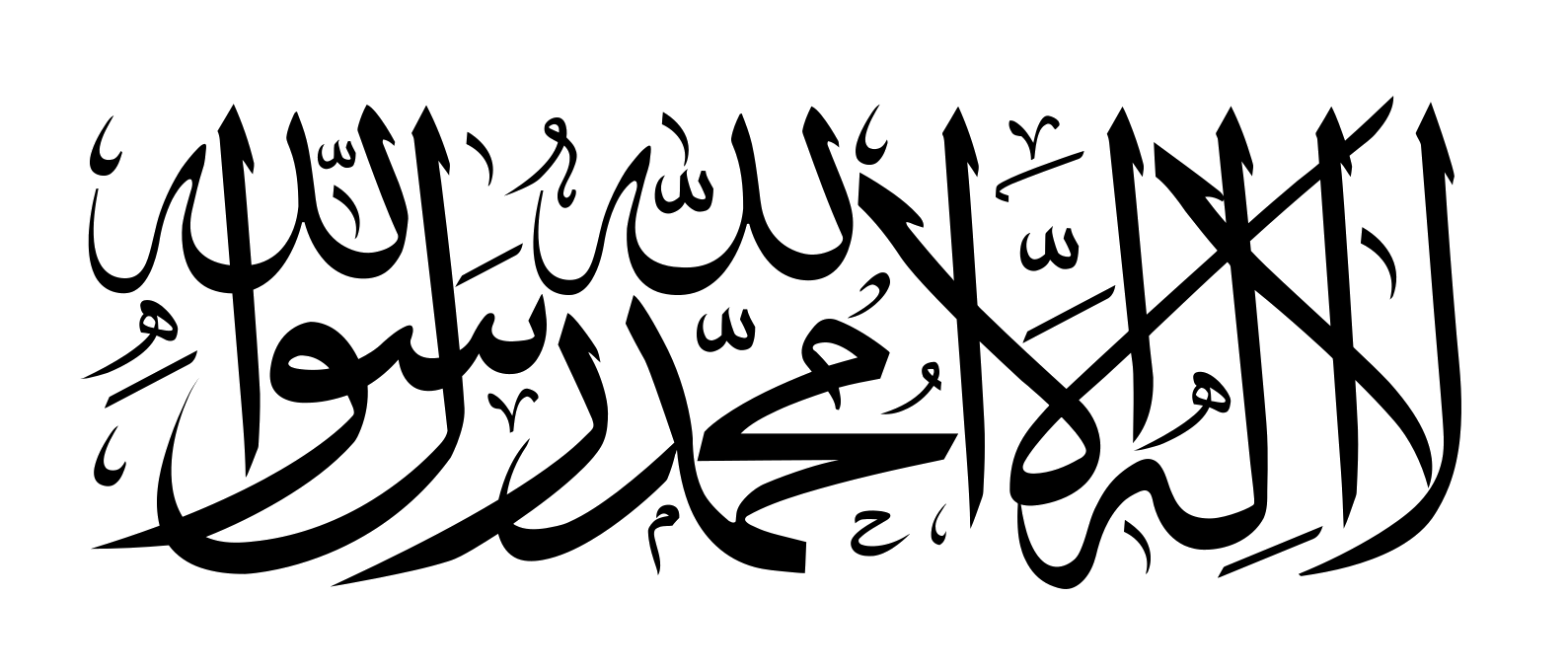 Afghanistan
Afghanistan
 Egypt
Egypt
 Azerbaijan
Azerbaijan
 Bahrain
Bahrain
 China
China
 India
India
 Iraq
Iraq
 Iran
Iran
 Israel
Israel
 Jordan
Jordan
 Cambodia
Cambodia
 Kasachstan
Kasachstan
 Kyrgyzstan
Kyrgyzstan

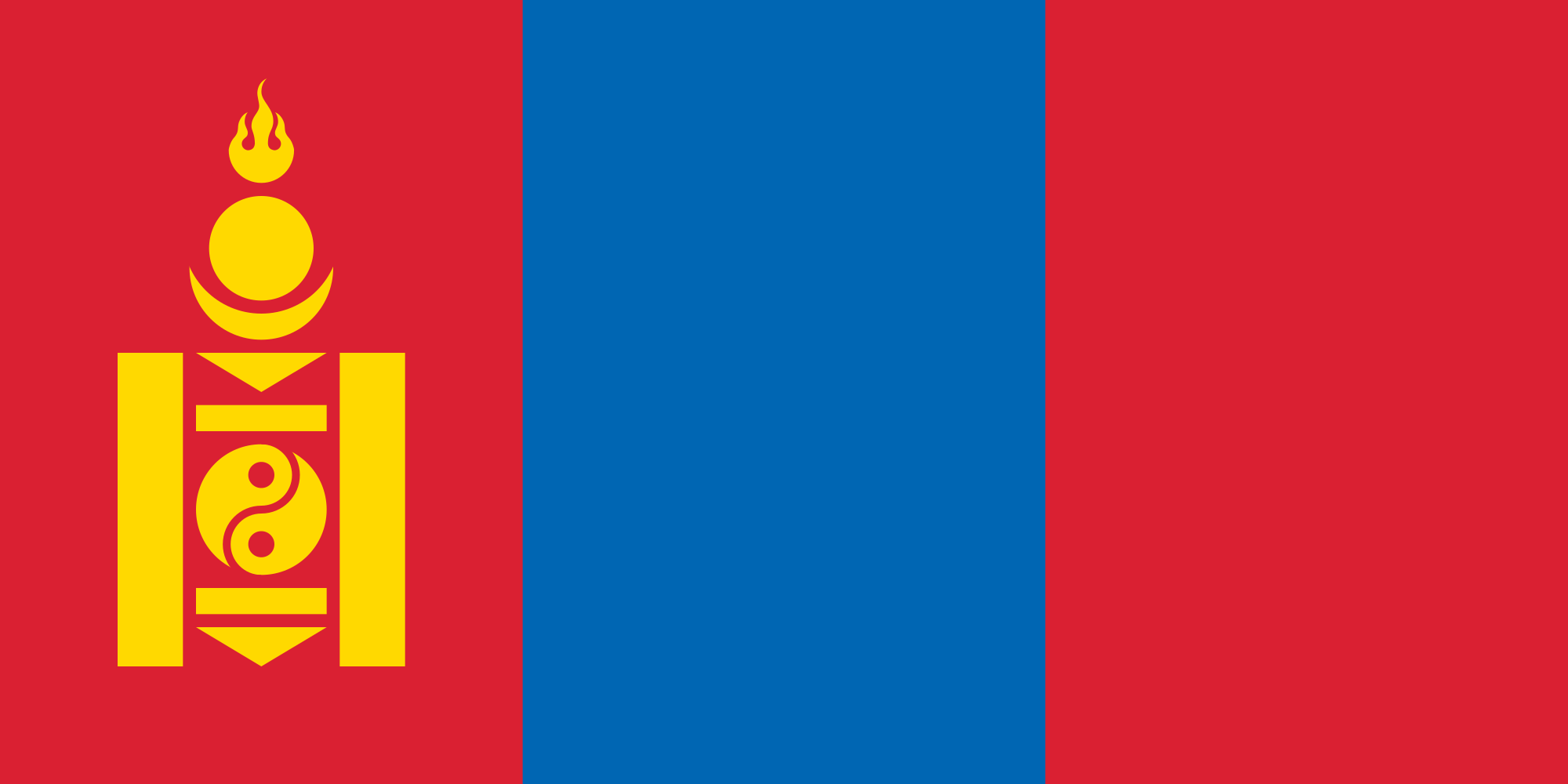 Mongolei
Mongolei
 Pakistan
Pakistan
 Palestine
Palestine
 Republic of Korea
Republic of Korea
 Russia
Russia
 Tajikistan
Tajikistan
 Thailand
Thailand
 Turkey
Turkey
 Uzbekistan
Uzbekistan
 United Arab Emirates
United Arab Emirates
 Vietnam
Vietnam
 *Mediterranean Sea
*Mediterranean Sea
 Egypt
Egypt
 Albania
Albania
 Algeria
Algeria
 Amber Road
Amber Road
 Bosnia Herzegovina
Bosnia Herzegovina
 France
France
 Gibraltar
Gibraltar
 Greece
Greece
 Israel
Israel
 Italy
Italy
 Croatia
Croatia
 Libanon
Libanon
 Libya
Libya
 Malta
Malta
 Malta
Malta
 Monaco
Monaco
 Montenegro
Montenegro
 Palestine
Palestine

 Review
Review
 Slovenia
Slovenia
 Spain
Spain
 Syria
Syria
 Tunisia
Tunisia
 Turkey
Turkey
 Cyprus
Cyprus

 *Mediterranean Sea
*Mediterranean Sea
 Egypt
Egypt
 Albania
Albania
 Algeria
Algeria
 Amber Road
Amber Road
 Bosnia Herzegovina
Bosnia Herzegovina
 France
France
 Gibraltar
Gibraltar
 Greece
Greece
 Israel
Israel
 Italy
Italy
 Croatia
Croatia
 Libanon
Libanon
 Libya
Libya
 Malta
Malta
 Morocco
Morocco
 Monaco
Monaco
 Montenegro
Montenegro
 Palestine
Palestine
 Slovenia
Slovenia
 Spain
Spain
 Syria
Syria
 Tunisia
Tunisia
 Turkey
Turkey
 Cyprus
Cyprus
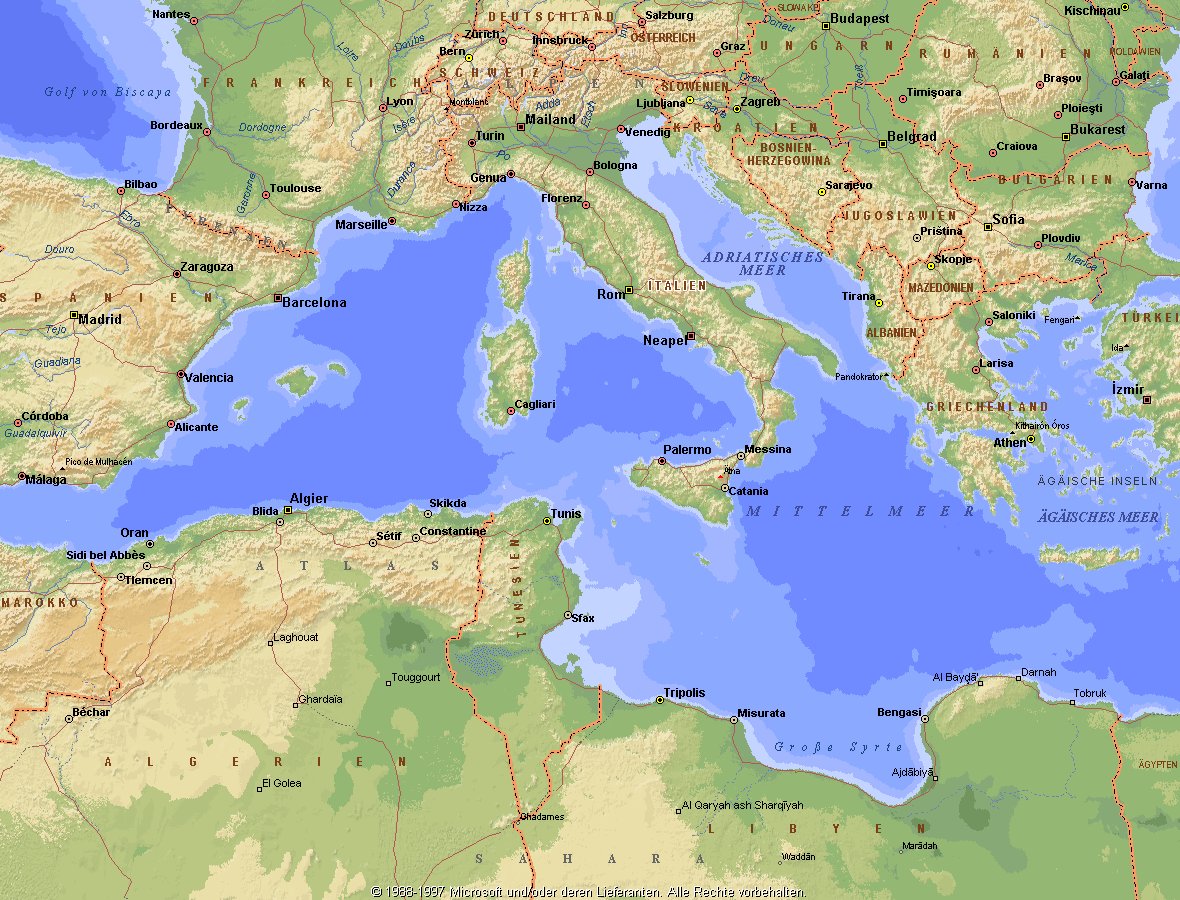
地中海,由北面的欧洲大陆,南面的非洲大陆以及东面的亚洲大陆包围着。东西长约4000千米,南北最宽处大约为1800千米,面积251.6万平方千米,是世界最大的陆间海。地中海的平均深度是1500米,最深处为5267米。
地中海西部通过直布罗陀海峡与大西洋相接,东部通过土耳其海峡(达达尼尔海峡和博斯普鲁斯海峡、马尔马拉海)和黑海相连。19世纪时开通了的苏伊士运河,接通了地中海与红海。 地中海是世界上最古老的海之一,[3] 而其附属的大西洋却是年轻的海洋。地中海处在欧亚板块和非洲板块交界处,是世界最强地震带之一。地中海地区有维苏威火山、埃特纳火山。
地中海作为陆间海,风浪较小,加之沿岸海岸线曲折、岛屿众多,拥有许多天然良好的港口,成为沟通三个大陆的交通要道。这样的条件,使地中海从古代开始海上贸易就很繁盛,促进了古代古埃及文明、古希腊文明、罗马帝国等的发展。现在也是世界海上交通的重要地区之一。其沿岸的腓尼基人、克里特人、希腊人,以及后来的葡萄牙人和西班牙人都是航海业发达的民族。著名的航海家如哥伦布、达·伽马、麦哲伦等,都出自地中海沿岸的国家。
地中海的沿岸夏季炎热干燥,冬季温暖湿润,被称作地中海性气候。植被,叶质坚硬,叶面有蜡质,根系深,有适应夏季干热气候的耐旱特征,属亚热带常绿硬叶林。这里光热充足,是欧洲主要的亚热带水果产区,盛产柑橘、无花果,和葡萄等,还有木本油料作物油橄榄。
Das Mittelmeer (lateinisch Mare Mediterraneum,[1] deshalb deutsch auch Mittelländisches Meer, präzisierend Europäisches Mittelmeer, im Römischen Reich Mare Nostrum) ist ein Mittelmeer zwischen Europa, Afrika und Asien, ein Nebenmeer des Atlantischen Ozeans und, da es mit der Straße von Gibraltar nur eine sehr schmale Verbindung zum Atlantik besitzt, auch ein Binnenmeer. Im Arabischen und Türkischen wird es auch als „Weißes Meer“ (البحر الأبيض/al-baḥr al-abyaḍ bzw. türk. Akdeniz) bezeichnet.
Zusammen mit den darin liegenden Inseln und den küstennahen Regionen Südeuropas, Vorderasiens und Nordafrikas bildet das Mittelmeer den Mittelmeerraum, der ein eigenes Klima (mediterranes Klima) hat und von einer eigenen Flora und Fauna geprägt ist.
地中海(ちちゅうかい、ラテン語: Mare Mediterraneum)は、北と東をユーラシア大陸、南をアフリカ大陸(両者で世界島)に囲まれた地中海盆地に位置する海である。面積は約3000平方キロメートル、平均水深は約1500メートル[2]。海洋学上の地中海の一つ。
地中海には、独立した呼称を持ついくつかの海域が含まれる(エーゲ海、アドリア海など)。地中海と接続する他の海としては、ジブラルタル海峡の西側に大西洋が、ダーダネルス海峡を経た北東にマルマラ海と黒海があり、南西はスエズ運河で紅海と結ばれている(「海域」「地理」で詳述)。
北岸の南ヨーロッパ、東岸の中近東、南岸の北アフリカは古代から往来が盛んで、「地中海世界」と総称されることもある[3]。
The Mediterranean Sea is a sea connected to the Atlantic Ocean, surrounded by the Mediterranean Basin and almost completely enclosed by land: on the north by Southern Europe and Anatolia, on the south by North Africa and on the east by the Levant. Although the sea is sometimes considered a part of the Atlantic Ocean, it is usually identified as a separate body of water. Geological evidence indicates that around 5.9 million years ago, the Mediterranean was cut off from the Atlantic and was partly or completely desiccated over a period of some 600,000 years, the Messinian salinity crisis, before being refilled by the Zanclean flood about 5.3 million years ago.
It covers an approximate area of 2.5 million km2 (965,000 sq mi), but its connection to the Atlantic (the Strait of Gibraltar) is only 14 km (8.7 mi) wide. The Strait of Gibraltar is a narrow strait that connects the Atlantic Ocean to the Mediterranean Sea and separates Gibraltar and Spain in Europe from Morocco in Africa. In oceanography, it is sometimes called the Eurafrican Mediterranean Sea or the European Mediterranean Sea to distinguish it from mediterranean seas elsewhere.[2][3]
The Mediterranean Sea has an average depth of 1,500 m (4,900 ft) and the deepest recorded point is 5,267 m (17,280 ft) in the Calypso Deep in the Ionian Sea. The sea is bordered on the north by Europe, the east by Asia, and in the south by Africa. It is located between latitudes 30° and 46° N and longitudes 6° W and 36° E. Its west-east length, from the Strait of Gibraltar to the Gulf of Iskenderun, on the southwestern coast of Turkey, is approximately 4,000 km (2,500 miles). The sea's average north-south length, from Croatia’s southern shore to Libya, is approximately 800 km (500 miles). The Mediterranean Sea, including the Sea of Marmara (connected by the Dardanelles to the Aegean Sea), has a surface area of approximately 2,510,000 square km (970,000 square miles).[4]
The sea was an important route for merchants and travellers of ancient times that allowed for trade and cultural exchange between emergent peoples of the region. The history of the Mediterranean region is crucial to understanding the origins and development of many modern societies.
The countries surrounding the Mediterranean in clockwise order are Spain, France, Monaco, Italy, Slovenia, Croatia, Bosnia and Herzegovina, Montenegro, Albania, Greece, Turkey, Syria, Lebanon, Israel, Egypt, Libya, Tunisia, Algeria, and Morocco; Malta and Cyprus are island countries in the sea. In addition, the Gaza Strip and the British Overseas Territories of Gibraltar and Akrotiri and Dhekelia have coastlines on the sea.
La mer Méditerranée (prononcé [me.di.tɛ.ʁa.ne]) est une mer intercontinentale presque entièrement fermée, bordée par les côtes d'Europe du sud, d’Afrique du Nord et d’Asie, depuis le détroit de Gibraltar à l'ouest aux entrées des Dardanelles et du canal de Suez à l'est. Elle s’étend sur une superficie d’environ 2,5 millions de kilomètres carrés. Son ouverture vers l’océan Atlantique par le détroit de Gibraltar est large de 14 kilomètres.
Elle doit son nom au fait qu’elle est littéralement une « mer au milieu des terres », en latin « mare medi terra »1.
Durant l’Antiquité, la Méditerranée était une importante voie de transports maritimes permettant l’échange commercial et culturel entre les peuples de la région — les cultures mésopotamiennes, égyptienne, perse, phénicienne, carthaginoise, berbère, grecque, arabe (conquête musulmane), ottomane, byzantine et romaine. L’histoire de la Méditerranée est importante dans l’origine et le développement de la civilisation occidentale.
Il mar Mediterraneo, detto brevemente Mediterraneo, è un mare intercontinentale situato tra Europa, Nordafrica e Asia occidentale connesso all'Oceano Atlantico. La sua superficie approssimativa è di 2,51 milioni di km² e ha uno sviluppo massimo lungo i paralleli di circa 3 700 km. La lunghezza totale delle sue coste è di 46 000 km, la profondità media si aggira sui 1 500 m, mentre quella massima è di 5 270 m presso le coste del Peloponneso. La salinità media si aggira dal 36,2 al 39 ‰.[2] La popolazione presente negli stati bagnati dalle sue acque ammonta a circa 450 milioni di persone.[2].
El mar Mediterráneo es uno de los mares del Atlántico. Está rodeado por la región mediterránea, comprendida entre Europa meridional, Asia Occidental y África septentrional. Fue testigo de la evolución de varias civilizaciones como los egipcios, los fenicios, hebreos, griegos, cartagineses, romanos, etc. Con aproximadamente 2,5 millones de km² y 3.860 km de longitud, es el segundo mar interior más grande del mundo, después del Caribe.1 Sus aguas, que bañan las tres penínsulas del sur de Europa (Ibérica, Itálica, Balcánica) y una de Asia (Anatolia), comunican con el océano Atlántico a través del estrecho de Gibraltar, con el mar Negro por los estrechos del Bósforo y de los Dardanelos y con el mar Rojo por el canal de Suez.2 Es el mar con las tasas más elevadas de hidrocarburos y contaminación del mundo.3
Средизе́мное мо́ре — межматериковое море, по происхождению представляющее собой глубоководную псевдоабиссальную внутришельфовую депрессию[1][2], связанную на западе с Атлантическим океаном Гибралтарским проливом[3].
В Средиземном море выделяют, как его составные части, моря: Адриатическое, Альборан, Балеарское, Ионическое, Кипрское, Критское, Левантийское, Ливийское, Лигурийское, Тирренское и Эгейское. В бассейн Средиземного моря также входят Мраморное, Чёрное и Азовское моря.

 Afghanistan
Afghanistan
 Egypt
Egypt
 Albania
Albania
 Algeria
Algeria
 Azerbaijan
Azerbaijan
 Bahrain
Bahrain
 Bangladesh
Bangladesh
 Benin
Benin
 Brunei Darussalam
Brunei Darussalam
 Burkina Faso
Burkina Faso
 Côte d´Ivoire
Côte d´Ivoire
 Djibouti
Djibouti
 Gabun
Gabun
 Gambia
Gambia
 Guinea
Guinea
 Guinea-Bissau
Guinea-Bissau
 Guyana
Guyana
 Indonesia
Indonesia
 Iraq
Iraq
 Iran
Iran
 Yemen
Yemen
 Jordan
Jordan
 Cameroon
Cameroon
 Kasachstan
Kasachstan
 Katar
Katar
 Kyrgyzstan
Kyrgyzstan
 Comoros
Comoros
 Kuwait
Kuwait
 Libanon
Libanon
 Libya
Libya
 Malaysia
Malaysia
 Malediven
Malediven
 Mali
Mali
 Morocco
Morocco
 Mauritania
Mauritania
 Mosambik
Mosambik
 Niger
Niger
 Nigeria
Nigeria
 Oman
Oman
 Organisation of Islamic Cooperation
Organisation of Islamic Cooperation
 Pakistan
Pakistan
 Palestine
Palestine
 Republic of the Sudan
Republic of the Sudan
 Saudi Arabia
Saudi Arabia
 Senegal
Senegal
 Sierra Leone
Sierra Leone
 Somalia
Somalia
 Suriname
Suriname
 Syria
Syria
 Tajikistan
Tajikistan
 Togo
Togo
 Tschad
Tschad
 Tunisia
Tunisia
 Turkey
Turkey
 Turkmenistan
Turkmenistan
 Uganda
Uganda
 Uzbekistan
Uzbekistan
 United Arab Emirates
United Arab Emirates

 Important International Organizations
Important International Organizations
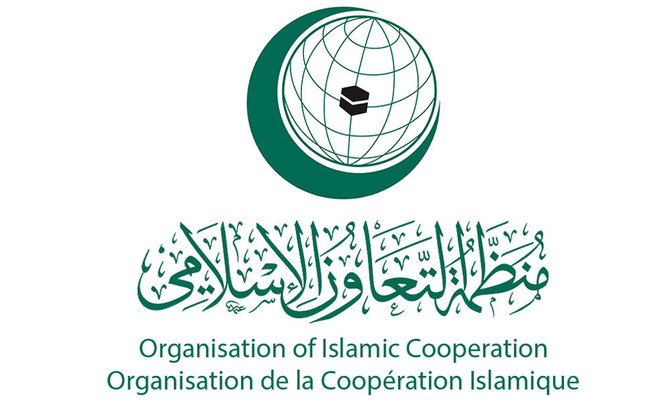
伊斯兰合作组织(阿拉伯语:منظمة التعاون الإسلامي;英语:Organisation of Islamic Cooperation;法语:Organisation de la coopération islamique)原名伊斯兰会议组织,是一个伊斯兰世界的政府间国际组织,为联合国大会观察员;该组织由遍及西亚(中东)、中亚、西非、北非、印度次大陆和东南亚的57个国家组成,覆盖的人口约为16亿。秘书处设在沙特阿拉伯王国的吉达市;现任秘书长是原沙特社会事务大臣Yousef Al-Othaimeen(从2016年开始)。
组织的宗旨是促进各成员国之间在经济、社会、文化和科学等方面的合作;努力消除种族隔离和种族歧视,反对一切形式的殖民主义;支持巴勒斯坦人民恢复民族权利和重返家园的斗争;支持穆斯林保障其尊严、独立和民族权利的斗争。
但要注意的是并非每个成员国是伊斯兰国家,如圭亚那、苏里南、莫桑比克、喀麦隆、乌干达和加蓬等国,伊斯兰反而是极少数人的信仰,阿尔巴尼亚则是唯一加入该组织的欧洲大陆的主权国家和联合国会员国,2011年脱离苏丹独立的南苏丹也在独立后脱离该组织的势力范围。
Die Organisation für Islamische Zusammenarbeit (arabisch منظمة التعاون الإسلامي, DMG Munaẓẓamat at-Taʿāwun al-islāmī; englisch Organization of Islamic Cooperation, OIC; französisch L’Organisation de Coopération Islamique, OCI; früher Organisation der Islamischen Konferenz) ist eine zwischenstaatliche internationale Organisation von derzeit 56 Staaten,[2] in denen der Islam Staatsreligion, Religion der Bevölkerungsmehrheit oder Religion einer nennenswerten Minderheit ist. Die Organisation nimmt für sich in Anspruch, den Islam zu repräsentieren. Mehrere größere Mitgliedsstaaten (Saudi-Arabien, Ägypten, die Türkei und der Iran) erheben hinter den Kulissen Führungsansprüche; die jeweils anderen Staaten bestreiten deren Recht dazu. Infolge dieser Rivalitäten ist die OIC seit 2017 kaum handlungsfähig.[3]
イスラム協力機構(イスラムきょうりょくきこう、アラビア語: منظمة التعاون الاسلامي、略称OIC; 英語: Organisation of Islamic Cooperation、略称OCI; フランス語: Organisation de la coopération Islamique)は、イスラム諸国をメンバーとして構成され、国際連合に対する常任代表を有する国際機構。公用語はアラビア語、英語、フランス語。かつてはイスラム諸国会議機構(منظمة المؤتمر الإسلامي、英語: Organisation of the Islamic Conference、フランス語: Organisation de la Conférence Islamique)という名称であったが、2011年6月にカザフスタンのアスタナでの会議で「イスラム協力機構」への変更と紋章が決定された[1]。
イスラム諸国の政治的協力、連帯を強化すること、イスラム諸国に対する抑圧に反対し、解放運動を支援することを目的とする。
加盟国はムスリム(イスラム教徒)が国民の多数を占める西アジア、北アフリカ、西アフリカ、東アフリカ、中央アジア、南アジア、東南アジアなどの57か国、オブザーバーが5ヵ国・8組織(国連など)からなり、世界13億人のムスリムの大部分を代表する。
加盟条件としては、国内でムスリムが大多数を占めることを必ずしも条件としているわけではなく、南アメリカのいくつかの国のようにマイノリティとしてある程度のムスリム人口を抱えているだけであっても、外相会議における審査で承認されればイスラム諸国のひとつとして機構に加盟することができる。イスラム教徒が多数派を占める国はほとんど参加しているが、イスラム教徒比率の高い国のうちエチオピア(30~50%)とタンザニア(約30%)が加盟していない。イスラム教徒人口の多い国で言えばインド(約1億5000万人)や中国(約2000万人)も加盟していない。逆にイスラム教徒比率の低い国ではガボン、ウガンダ、スリナム、ガイアナなどが加盟している(それぞれ10%未満)。
The Organisation of Islamic Cooperation (OIC; Arabic: منظمة التعاون الإسلامي; French: Organisation de la coopération islamique), formerly the Organisation of the Islamic Conference, is an international organization founded in 1969, consisting of 57 member states, with a collective population of over 1.8 billion as of 2015 with 53 countries being Muslim-majority countries. The organisation states that it is "the collective voice of the Muslim world" and works to "safeguard and protect the interests of the Muslim world in the spirit of promoting international peace and harmony".[1]
The OIC has permanent delegations to the United Nations and the European Union. The official languages of the OIC are Arabic, English, and French.
L’Organisation de la coopération islamique (OCI), en arabe : منظمة التعاون الإسلامي (Munaẓẓamat at-Taʿāwun al-islāmī), en anglais : Organisation of Islamic Cooperation (OIC), appelée jusqu'en 2011 Organisation de la conférence islamique (en arabe : منظمة المؤتمر الإسلامي, en anglais : Organisation of the Islamic Conference), est une organisation intergouvernementale créée le 25 septembre 1969. Son siège se situe à Djeddah en Arabie saoudite et elle possède une délégation permanente aux Nations unies.
Regroupant 57 États membres, sa vocation est de promouvoir la coopération dans les domaines économiques, sociaux, culturels et scientifiques (grâce notamment à la Banque islamique de développement), mais aussi la sauvegarde des lieux saints de l'islam ou encore le soutien au peuple palestinien. À l'échelle mondiale, il n'existe pas d'autre organisation confessionnelle dont les membres signataires soient des États.
Ses trois langues officielles sont l'arabe, l'anglais et le français2.
L'Organizzazione della cooperazione islamica (in arabo: منظمة التعاون الإسلامي, Munaẓẓamat al-taʿāwun al-islāmī; in inglese: Organization of the Islamic Cooperation, OIC; in francese: Organisation de la coopération islamique, OCI) è un'organizzazione internazionale con una delegazione permanente presso le Nazioni Unite. Rappresenta 56 Stati dell'Europa, Vicino Oriente, Medio Oriente, America meridionale, Africa, Asia centrale e del Subcontinente indiano.[1]
L'organizzazione, fondata a Rabat, in Marocco, il 25 settembre 1969 con il nome Organisation of the Islamic Conference, in arabo: منظمة المؤتمر الإسلامي, Munaẓẓamat al-muʾtamar al-islāmī; (FR) Organisation de la conférence islamique, mutato nell'attuale nel 2011.[2]
Ha come finalità la salvaguardia degli interessi e lo sviluppo delle popolazioni musulmane nel mondo.
Il 10 ottobre 1975 le è stato riconosciuto lo status di osservatore dell'Assemblea generale delle Nazioni Unite.
La Organización para la Cooperación Islámica (Árabe:منظمة التعاون الاسلامي); (Francés: Organisation de la Coopération Islamique); (Inglés: Organisation of Islamic Cooperation) es un organismo internacional que agrupa a los estados de confesión musulmana, creado en 1969 durante la Conferencia de Rabat y formalizada dos años después.
Su sede está en Yidda, ciudad costera de Arabia Saudí a orillas del Mar Rojo. Sus miembros son países con mayoría de población musulmana o con una comunidad significativa en ellos, con Estados miembros y observadores de África, Asia, Europa y América del Sur. El 28 de junio de 2011 se oficializó el cambio de nombre,1 anteriormente se llamó: Organización de la Conferencia Islámica (Árabe:منظمة المؤتمر الإسلامي); (Francés: Organisation de la Conférence Islamique); (Inglés:Organization of the Islamic Conference).
Sus acciones se circunscriben a la actividad colaborativa entre sus miembros, sobre todo en la lucha contra el imperialismo, el neocolonialismo y por la emancipación de Palestina. Históricamente se celebraron diversos congresos que contribuyeron con su desarrollo: Lahore (1974), La Meca (1981), Casablanca (1984), Kuwait (1987), Dakar (1991). Sus repercusiones son menores que las de la Liga Árabe.
Организация исламского сотрудничества (англ. Organisation of Islamic Cooperation (OIC), араб. منظمة التعاون الاسلامي) — международная организация исламских стран (до 2011 года называлась Организация Исламская конференция (ОИК).
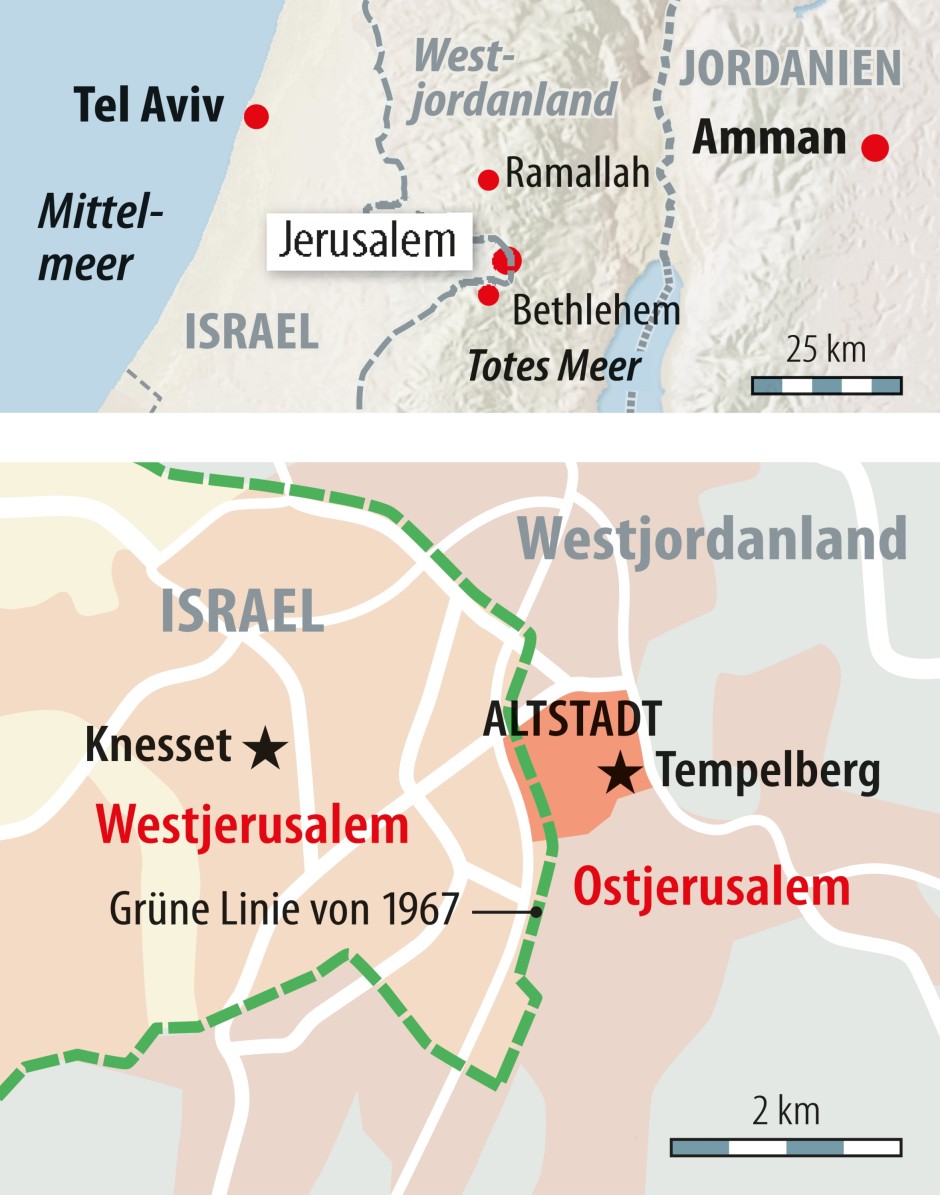

 International cities
International cities

 Religion
Religion
 World Heritage
World Heritage
 Architecture
Architecture
 History
History
 Art
Art
 Literature
Literature
 Music
Music
 Geography
Geography
 Hand in Hand
Hand in Hand
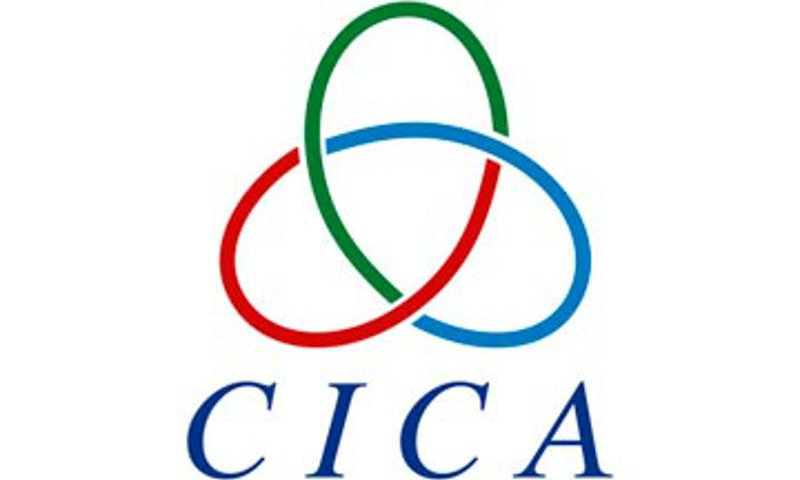
 Party and government
Party and government